Minnestar
Reflections on Twin Cities tech‑community events—Minnebar, Minnedemo and more. I explain the origin of “Minnebar,” recap sessions I attended and celebrate the people powering our thriving tech scene.
- Joy
- Whimsy
- New People
- Surprise
- Be kind
- Play well with others
- Clean up your messes
- Woody Guthrie inspired quote
- Build capacity to imagine; Build capacity to act
- Computer science and ethics
- Government and companies. What is intersection.
- Options: embrace, ignore, rationalize, adjust, refuse, expose, sabotage, and document
- Business to raise queens that can withstand local winters.
- Technology and Bee Keeping
- Hive Scribe: Note Taking app for sticky fingers
- HiveGenie
- Temperature humidity weight
- Seems data for sake of data. Does it matter
- Too late to take action
- BroodMinder
- HiveTool: Open source, Raspberry Pi
- QR codes attached to bees
- BeeHero
- Four Seasons Apiaries
- Not a dev but using Cursor to create prototype.
- 2,137% increase in deep fake fraud in last three years
- Good and bad use cases.
- Media examples.
- Great examples of deep fakes and how convincing can be.
- Take it down act. Amy Klobouchar coauthored it.
- Deepfakes as phishing and scams
- Deepfakes as selling avatars on shopping streams.
- “Content hole”
- Pickle
- Deep fakes of you in your office?
- TikTok digital avatars
- Proof of humanity
- World coin
- Call to action: Create a family password.
- Recap of session.
- For sure the first Minnebar session ever to have an accordian played.
- Great framing around having a beginners mind!
- Reminded me of Punk Rock, just play, stop thinking so much.
- Lessons:
- Getting going is 1,000x easier than your dumb brain thinks.
- Set (and reset) your goal.
- Work around constraints; work everywhere.
- Your sense of how good you are is weird.
- You are ready enough!
- Being a beginner is the best.
- Types of 3D printers
- Types of filaments / resin
- Software for creating objects
- Slicing software for prepping files for printing
- Caveats, considerations, and drawbacks
- Safety
- Do not use bullet points unless the speaker clearly uses them.
- Preserve all first-person phrasing and casual language.
- Remove filler words like ‘so’, ’like’, and ‘kind of’ unless they assist readability.
- Ensure the article can stand alone for publication.
- Feedbin: This is where all my RSS feeds live–around 300 of them. It’s fast, stable, and does exactly what I need. For $30 a year, it’s an incredible value. No fluff, just the right features.
- Unread: This is the mobile app I use to actually read those feeds. It’s ridiculously fast and makes getting through content frictionless. I don’t want to waste time loading or tapping around.
- Safari: Specifically for the Reading List. I like that it’s integrated across all my Apple devices, and it’s a really handy staging area between “that looks cool” and “this is newsletter-worthy.”
- Pinboard: The workhorse. I have over 15,000 links in there and it’s still lightning fast. It hasn’t been updated in years–and I love that. No surprises. It’s rock solid.
- Drafts: This is where my text starts. It’s not a notes app. It’s a place where text goes to live temporarily, get processed, get acted upon. I have a system in there for my Currently section, where I jot down stuff throughout the week.
- Data Jar: A magical tool. Think of it like shared memory across Shortcuts. Shortcut A writes something, Shortcut B can read it. Without it, this whole thing would be way more complex to stitch together.
- Shortcuts: This is the engine. Every section of the newsletter is its own Shortcut. The Build script just stitches them together. It’s modular, easy to extend, and Apple keeps improving it.
- Buttondown: The sending platform. I used Mailchimp for a while, and it made me feel like I needed to be a marketer. Buttondown talks like a newsletter author. It supports Markdown, doesn’t try to get fancy with HTML, and keeps things straightforward.
- OmniFocus: My GTD backbone. I track everything in here, and it gives me clarity on what needs to be done and when.
- Stripe: This is tied to Buttondown to handle Supporting Memberships. Super easy to set up, and now I’m raising funds for digital nonprofits through it.
- OpenAI: New to the stack. I’m using it for help with subject lines, fortunes, and membership messaging. But always with control–I want it to help, not replace my voice.
- Largest minnebar ever
- 167 sessions
- Over 2,000 registered attendees
Blog Categories via LLM
After using GPT-5 to create category introductions for my website I got to thinking about the categories themselves.
With over 9,800 blog posts spanning 20+ years it is daunting to figure out an approach to categories. It is especially daunting to approach them in a way that would make sense to a visitor to my website. As a test, I gave this challenge to GPT-5 using Agent mode. It took 31 minutes to do the research. I have no idea how many web pages it hit on my site (I wasn’t watching!). It gave me a whole report and the results seem really solid.
Each one of these is also provided a description and examples posts that would fit into it. This seems like a great place to use AI.
Going through my blog and assigning posts to these categories could be done with a script and some vibe coding. Perhaps this will be a winter project for me.
All of this has me thinking that it would be nice for micro.blog to do this for me. I wouldn’t mind having micro.blog use AI to recommend categories for me. But then separately, now that we have categories with introduction text take each of my blog posts and ask the LLM to categories it into the existing structure. All the data is there. 🤔
What does Minnebar mean?
I was having a conversation last week about Minnebar and there was a question about the name. What does it mean? Why Minnebar? It has nothing to do with being a bar with drinks. And it isn’t mini!
A super abbreviated history to get to the name.
It starts with Tim O’Reilly and O’Reilly Media. At one point O’Reilly hosted these “Friends of O’Reilly” events which as an acronym is FOO. It was Friends of O’Reilly, or Foo Camp. These were special events with an open agenda. Think wiki meets conference — or unconference.
The community decided there should be more of these to encourage sharing ideas in an unstructured way. In 2005 the first BarCamp was hosted to do that. In programming the most common variable reference is foobar, which isn’t the military fubar. So, not FooCamp but BarCamp.
There were BarCamps all over the place. It was a big trend. So when Ben, Luke, and a handful of folks decided we should have one in Minneapolis. But instead of it being BarCamp Minneapolis, let’s brand it a bit. Minnebar!
That is how you get there. So Minnebar is the largest unconference in North America, and I’m nearly positive it is also the longest running.
My Minnebar 19 in Sessions
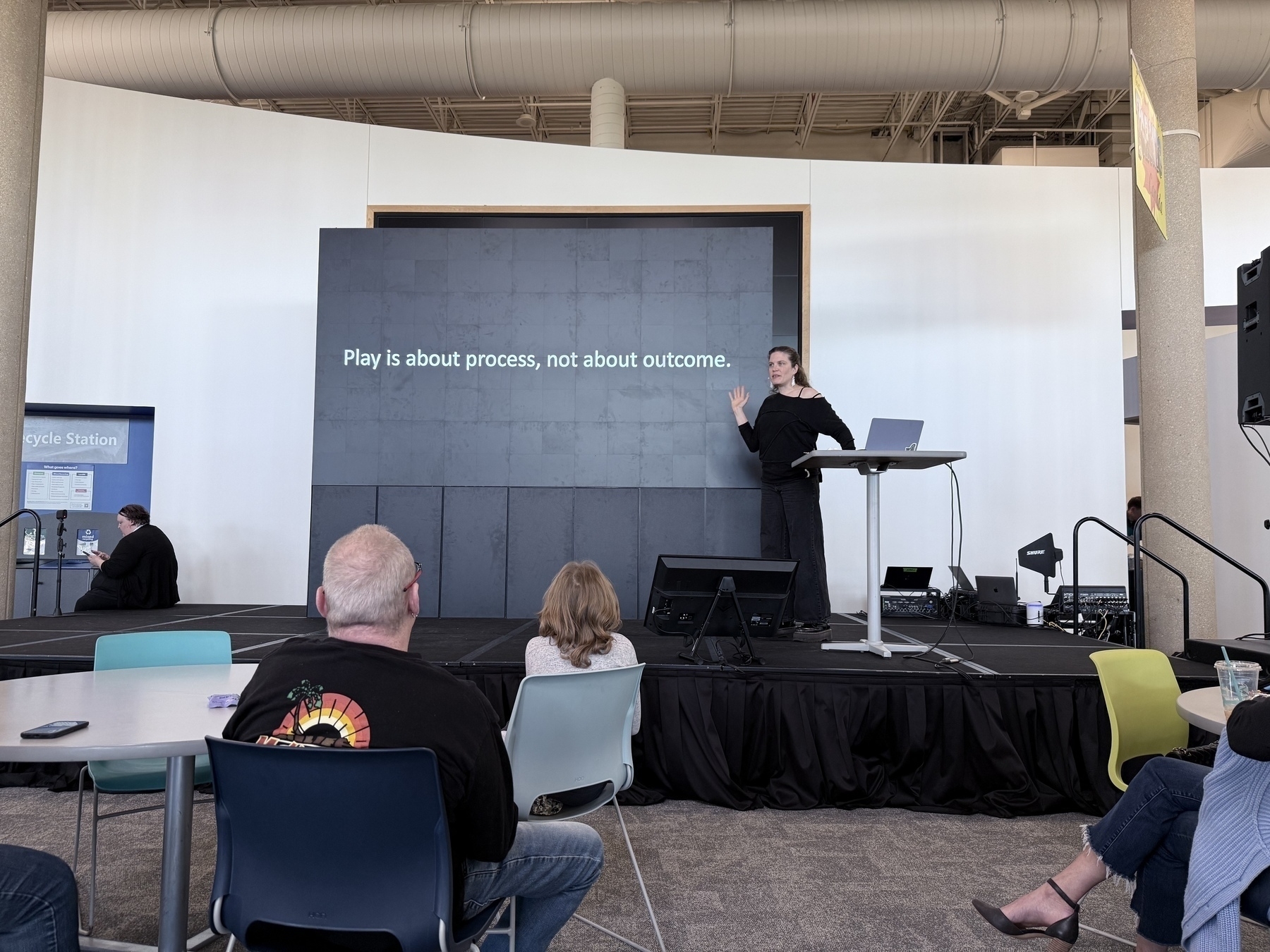
Session 0 feat. Dr. AnnMarie Thomas!
AnnMarie is an engineer. An artist. An educator. A maker. A writer. A lifelong learner who built her career mixing science, art, tech, and curiosity into something new – over and over again.
From Squishy Circuits (playdough that lights up!) to OK Go Sandbox (music videos as STEAM playgrounds), to founding the Playful Learning Lab (at the University of St. Thomas), her work reminds us: when we make space for play, we make space for possibility.
Today, she leads Listo Idea Co., LLC, where she consults on projects ranging from workshop design to ocean focused VR/AR. She’s also an enthusiastic amateur in a wide range of hobbies – including trapeze and magic.
Recipe for play:
Playful learning rules:
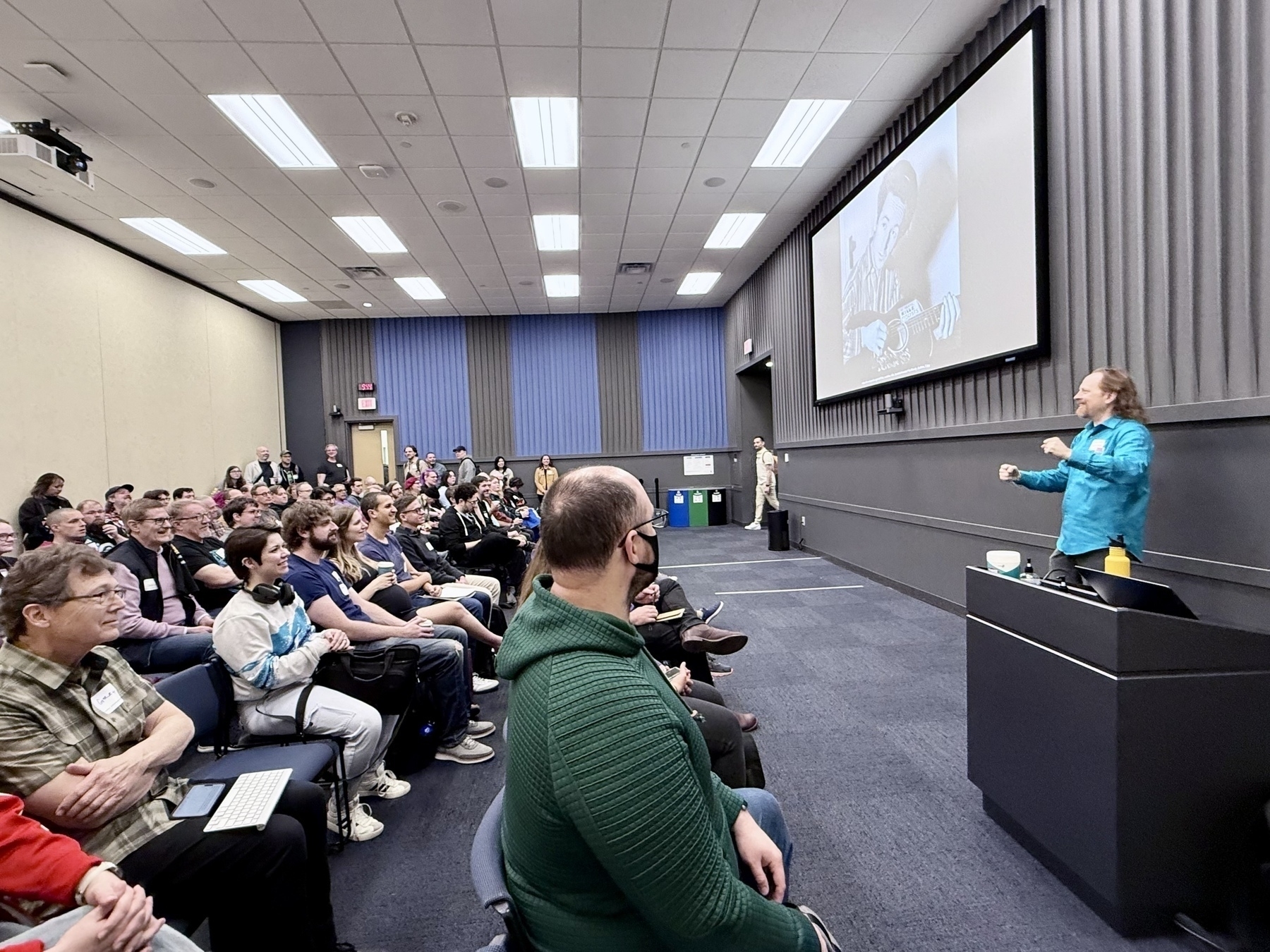
This Machine ____s Fascists (fill in the blank)
Around the world and at home, democracy is in decline and authoritarianism is on the rise. Technology is smack dab at the center of this authoritarian movement, both in terms of how it spreads and in terms of the damage it can do. Unfortunately, as designers, builders, managers, and funders of technology, we cannot look away.
What actions can we, the creators and stewards of technology, take to protect democracy and human rights? What power do we have when our own spheres of influence feel small? What harms are preventable? What harms are not obvious? What choices do we have? What kinds of action can we take?
When presented with an ethical dilemma, how will you fill in that blank?
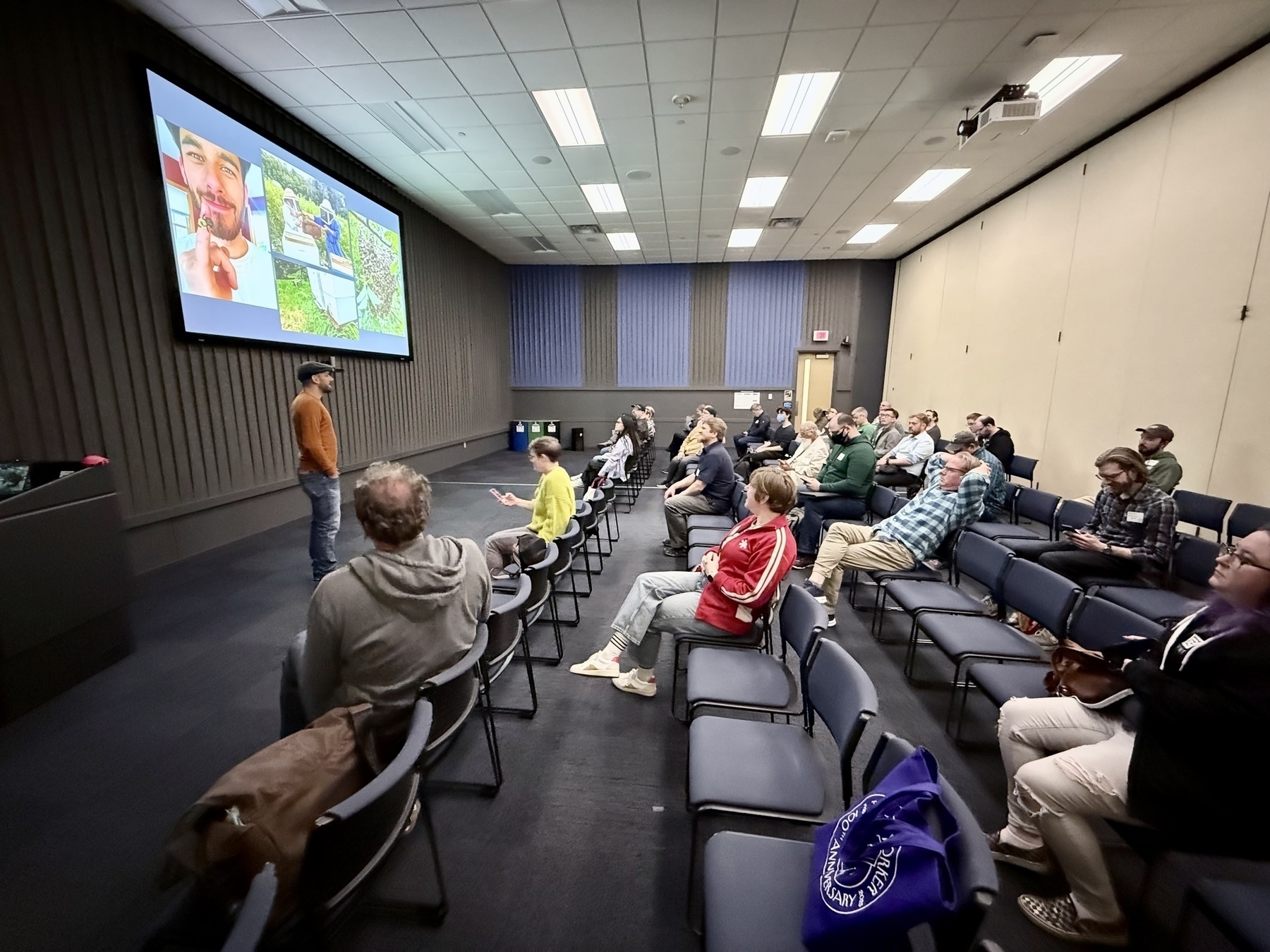
🐝 Honeybees: Click to Save
Joe Meyer
Technology and beekeeping might seem like an unlikely pairing, but the “Save the Bees” movement has inspired a surge of tech innovation in the hive. In this session, we’ll take a look at the gadgets and technologies gaining traction in the beekeeping world. I’ll also talk about my own personal journey developing an app using AI not to disrupt tradition, but to support it. This talk is for anyone interested in the tension between tradition and innovation, and how we can design technology that honors the communities it’s meant to serve.
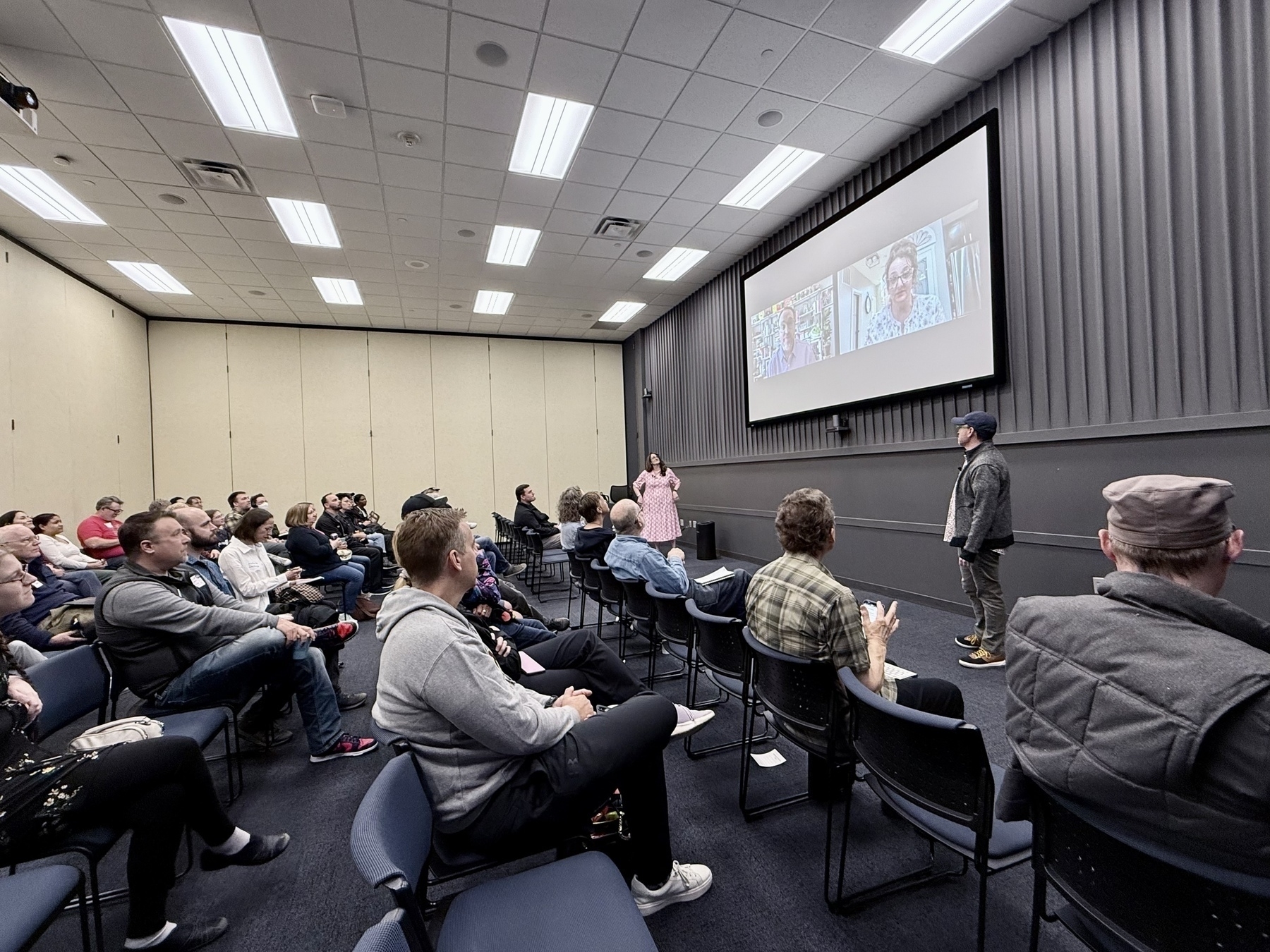
Deepfakes 101: What’s Real, What’s Not, and What to Do About It
Greg Swan, Jenny Swan
Deepfake fraud attempts have skyrocketed by 2137% in just three years. And today, it takes less than 27 seconds to clone someone’s voice.
But what is a deepfake, and why should you care? AI-generated misinformation is more than just a tech curiosity–it’s a growing threat to trust, security, and even your personal identity. If people can’t tell reality from manipulation, skepticism toward AI will only grow.
Join Jenny and Greg Swan from _The Cave Project_as they break down how deepfakes work, the risks they pose, and (most importantly) what you can actually do about it. From setting up family passwords to recognizing red flags, this session will arm you with the knowledge to stay ahead of the fake.
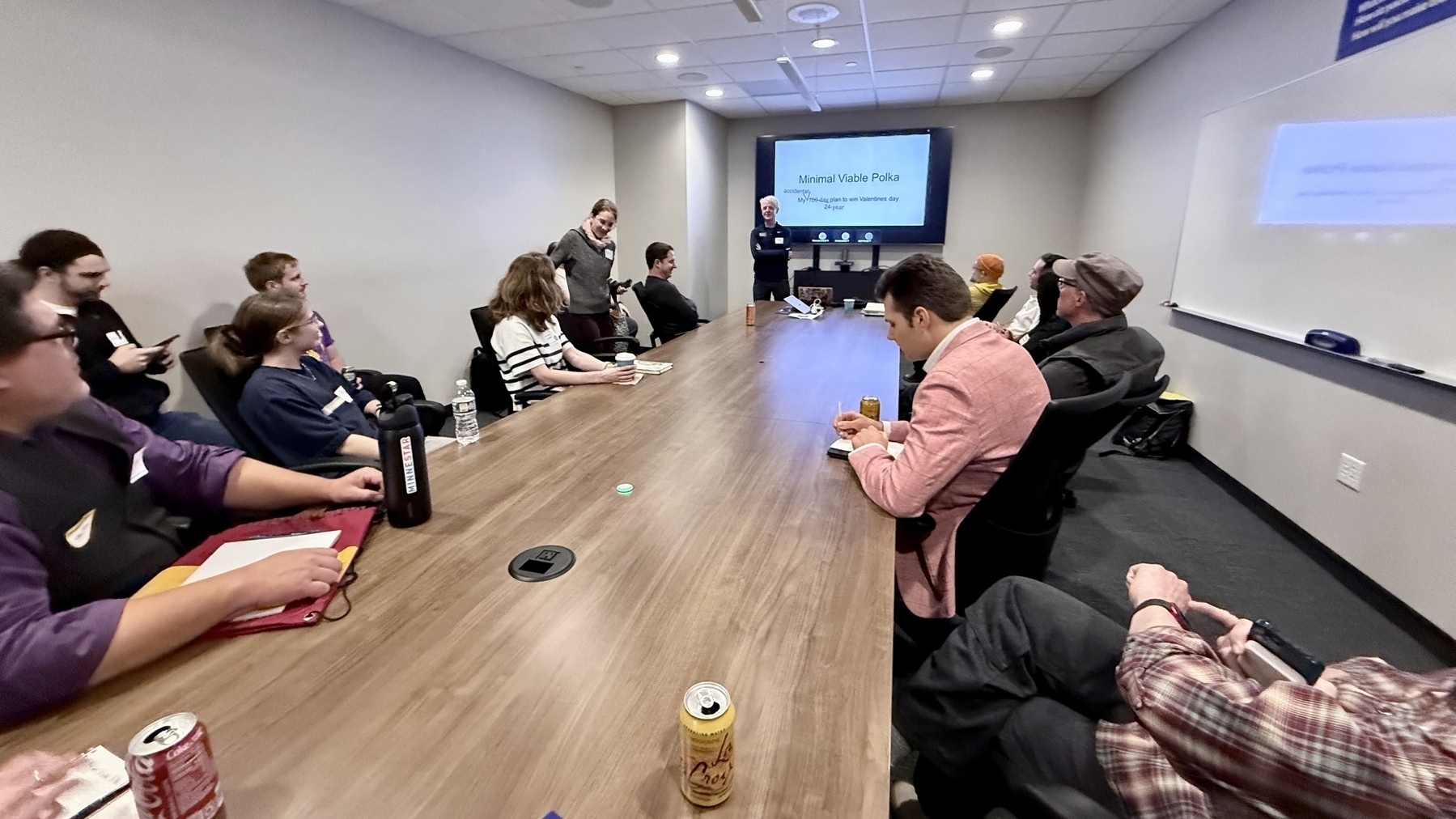
Minimal Viable Polka: My 100 day plan to win valentines day
Jim Bernard
This personal narrative includes practical tips and easy-to-implement suggestions that can be applied to your life. Bring your groaning to-do list, spiraling imposter syndrome and be prepared to be bossed into doing that thing that you’ve always wanted to do. You’ve got this!
WARNING: This session will include a modest amount of beginner accordion music.

3D Printing: How to Get Started
Cameron MacDonald
Are you interested in 3D printing but don’t know how to get started?
This session is to give newcomers to 3D printing a rundown of what it is, what it isn’t, and how to start trying it out if you’re interested.
We’ll be exploring:
There will be time for a Q&A at the end for anyone who has specific questions. 3D printing is an exciting, fun, sometimes frustrating, and extremely vast and deep hobby. I hope you’ll join and find out more about one of my favorite hobbies!
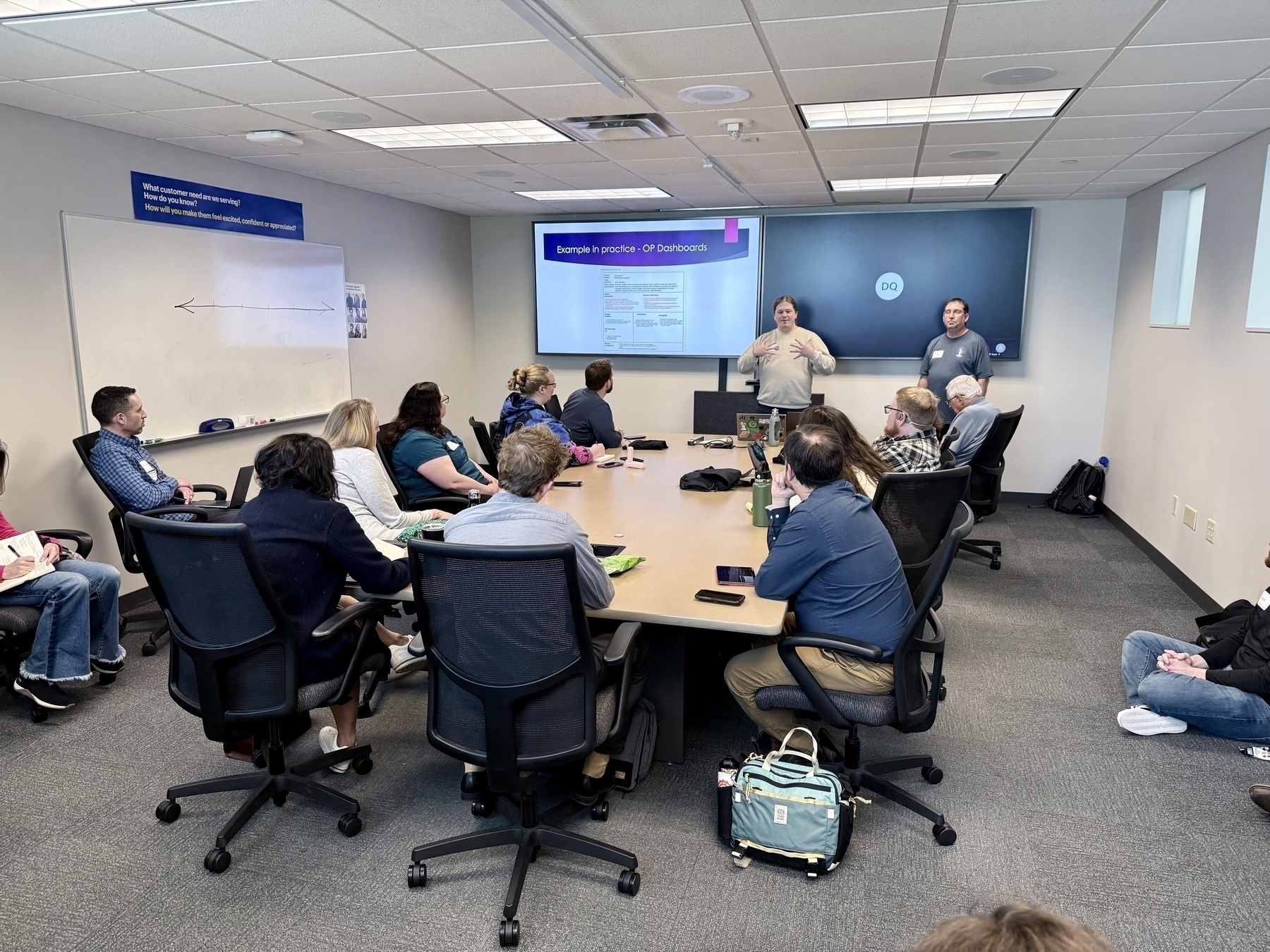
Build game changing products using Product Discovery workshops
Bill Gintz, David Quinn
This presentation will delve into the dynamic use of Product Discovery workshops within our organization. We’ll explore the insights our team has garnered through these sessions and illustrate how they can help synchronize product, delivery, and stakeholder teams. This alignment will pave the way for a more efficient, stress-free delivery process, ultimately leading to the creation of game-changing products.
Great TeamSPS presentation on using discovery to make sure your doing the right things in the right way.
How To Newsletter
This was my session, you can read the article version.
How to Newsletter: Lessons from 300 Issues of the Weekly Thing
This is an article version of the presentation I gave at Minnebar 19 on How to Newsletter.
To create this I used Whisper Memos on my iPhone to capture the transcription. I did some general editing to remove some preamble and ad hoc dialog, did a read through to correct any obvious issues, and added images for each of my slides. I then asked GPT o3 to use the transcription to create an article using this prompt:
I have a raw transcript of a talk. Please convert it into a well-structured written article that preserves the speaker’s voice, tone, and all content exactly as it was spoken–do not omit or add anything. Improve readability by correcting grammar and sentence flow, organizing content into appropriate paragraphs, and inserting section breaks that follow the speaker’s original structure. Do not turn this into a summary or reinterpret the ideas. Use images from the transcript as section markers when available. Maintain the informal, personal tone of the speaker throughout.
With a proofread here is that version of this presentation.

What I wanted to talk about is “How To Newsletter.” I’ve been sending a newsletter now for eight years, and I’ve learned a lot in that process. I thought it’d be fun to share that knowledge. I actually planned to do this session in 2023–so if you’re thinking, “Didn’t he already do this?”–I had to cancel it that year. Now we’re two years later, and I’ve got two more years of learnings and 50 more issues of my newsletter under my belt.
As I put this talk together, I realized it’s not just about how to newsletter. It could also be about how to run a complex side project, or how to consistently do something for eight years. It’s also about how to apply automation to make that kind of work easier. So, depending on what you’re looking for, you might take away more than just newsletter tips–this is also about managing a long-term, detailed endeavor.
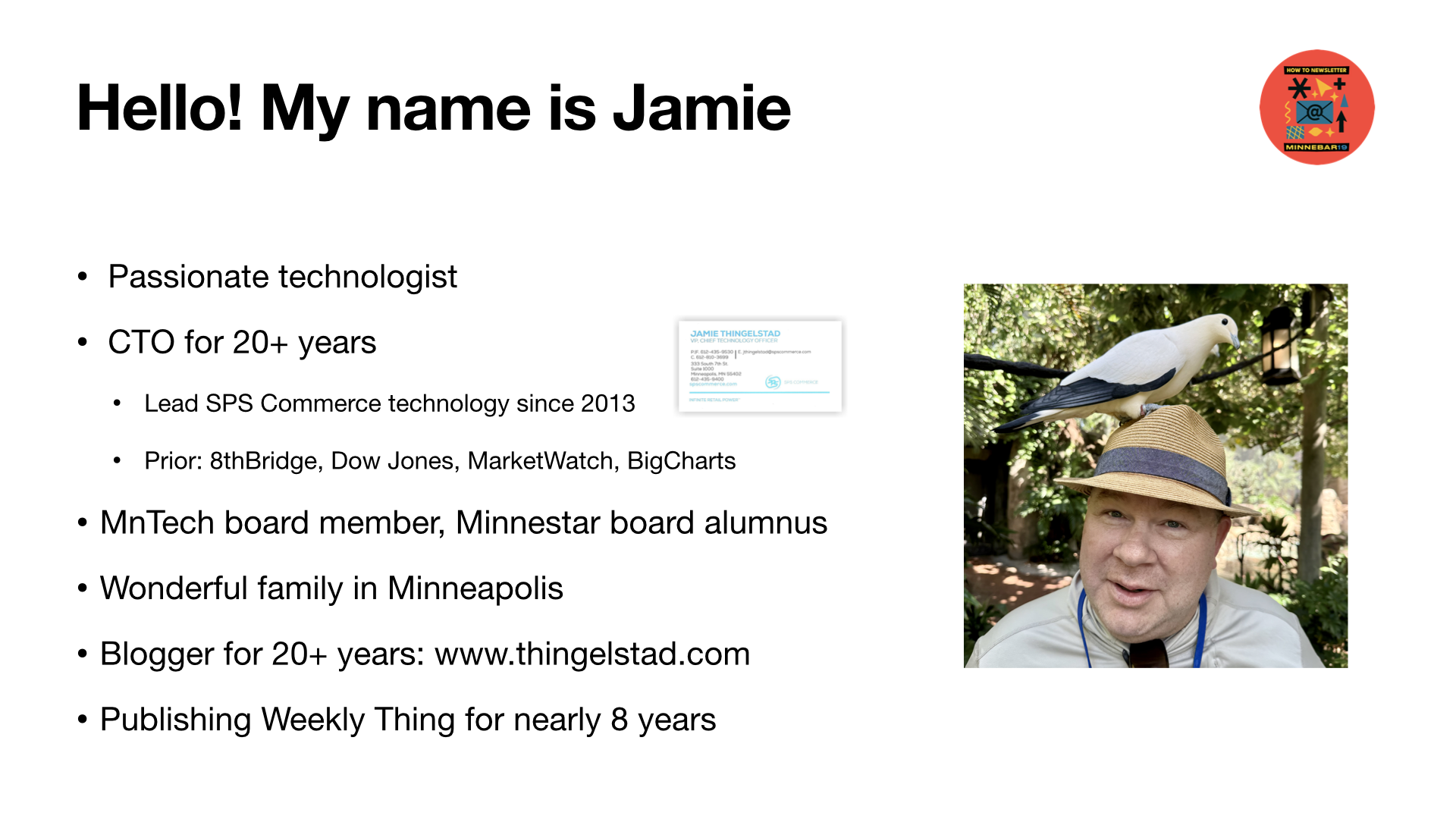
First, who am I? I’m Jamie Thingelstad. I’m a passionate technologist. I’ve been into tech since I was a kid, started programming BASIC on a TRS-80–you can figure out my age from that–and I’ve always loved building things. I’ve had a 20+ year career as a Chief Technology Officer, came into the field as the web was being born, built a couple of companies, and eventually started building things with groups to do even bigger work.
I’m on the board of the Minnesota Technology Association and previously served on the board of Minnestar. I live in Minneapolis with my wonderful family. I’ve also been a blogger for 20+ years–which plays a big role when we talk about newsletters–and I’ve been publishing The Weekly Thing for eight years now.
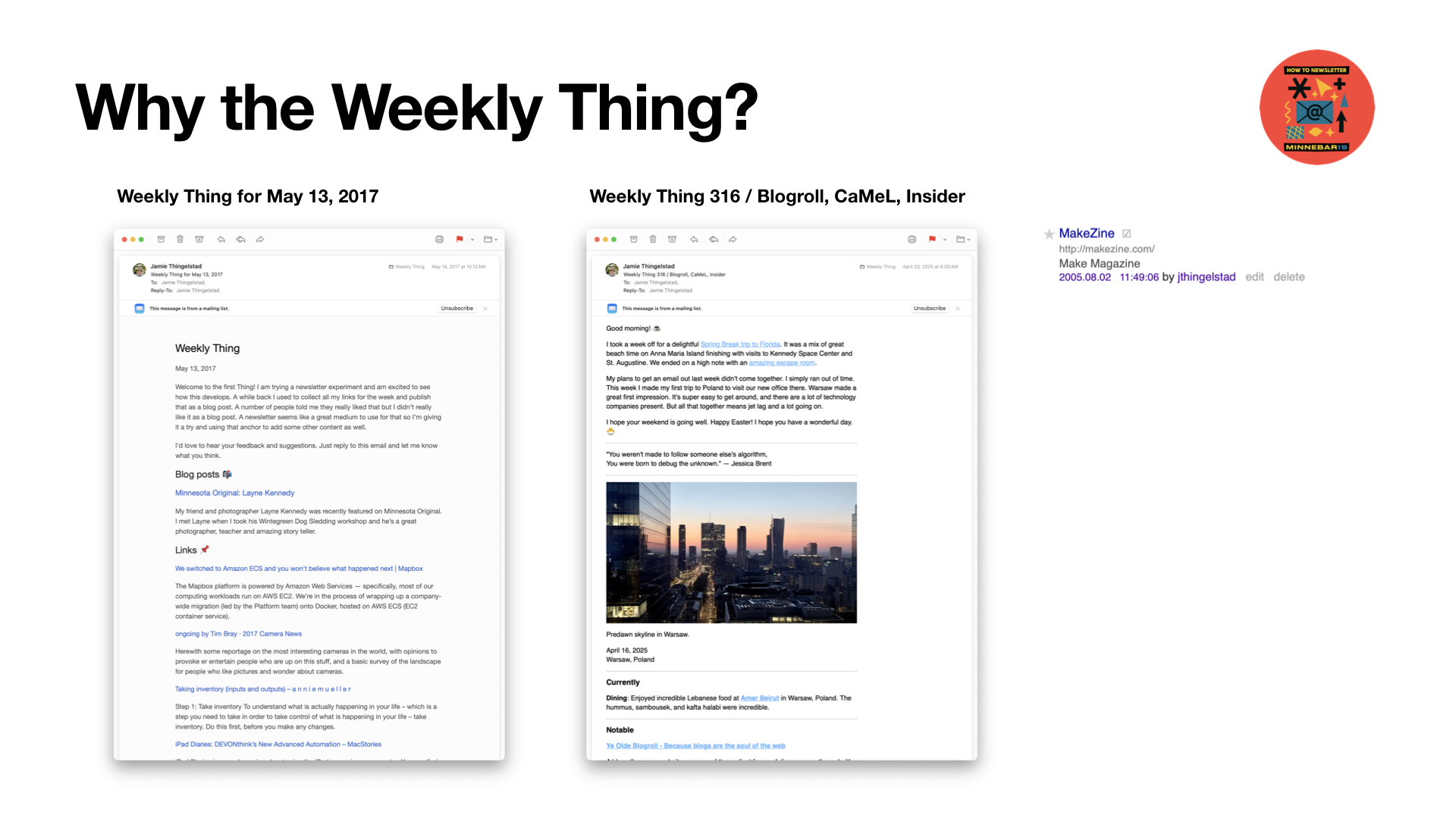
Why a newsletter? What led me to start The Weekly Thing? The image here shows the very first issue from May 13, 2007–it looked totally different from current issues. The one shown here is issue 316 from two weeks ago.
Back in 2017, newsletters were having a moment. People were launching them, companies were seeing them as a way to go directly to inboxes and bypass platforms. That intrigued me. I’d been blogging for over a decade and wanted to play with the newsletter medium. But then came the question: what would I put in it?
I’ve always been a voracious consumer of online content. I used bookmarking services like del.icio.us (anyone remember that?) and later Pinboard. My first bookmark is from August 2005. At one point, I thought about making a link blog, but it didn’t vibe with me. So I combined that impulse with the newsletter idea and decided I’d curate and share content I found interesting each week.
Importantly, I ignored most of the newsletter “growth hacks.” I’m cynical about stuff like that. I just wanted to share good content, without any tricks. I didn’t have a specific topic, but I committed to doing it for a year. Now, eight years later, it’s still a fun and meaningful project, and I feel like I’m giving back by sharing useful information.
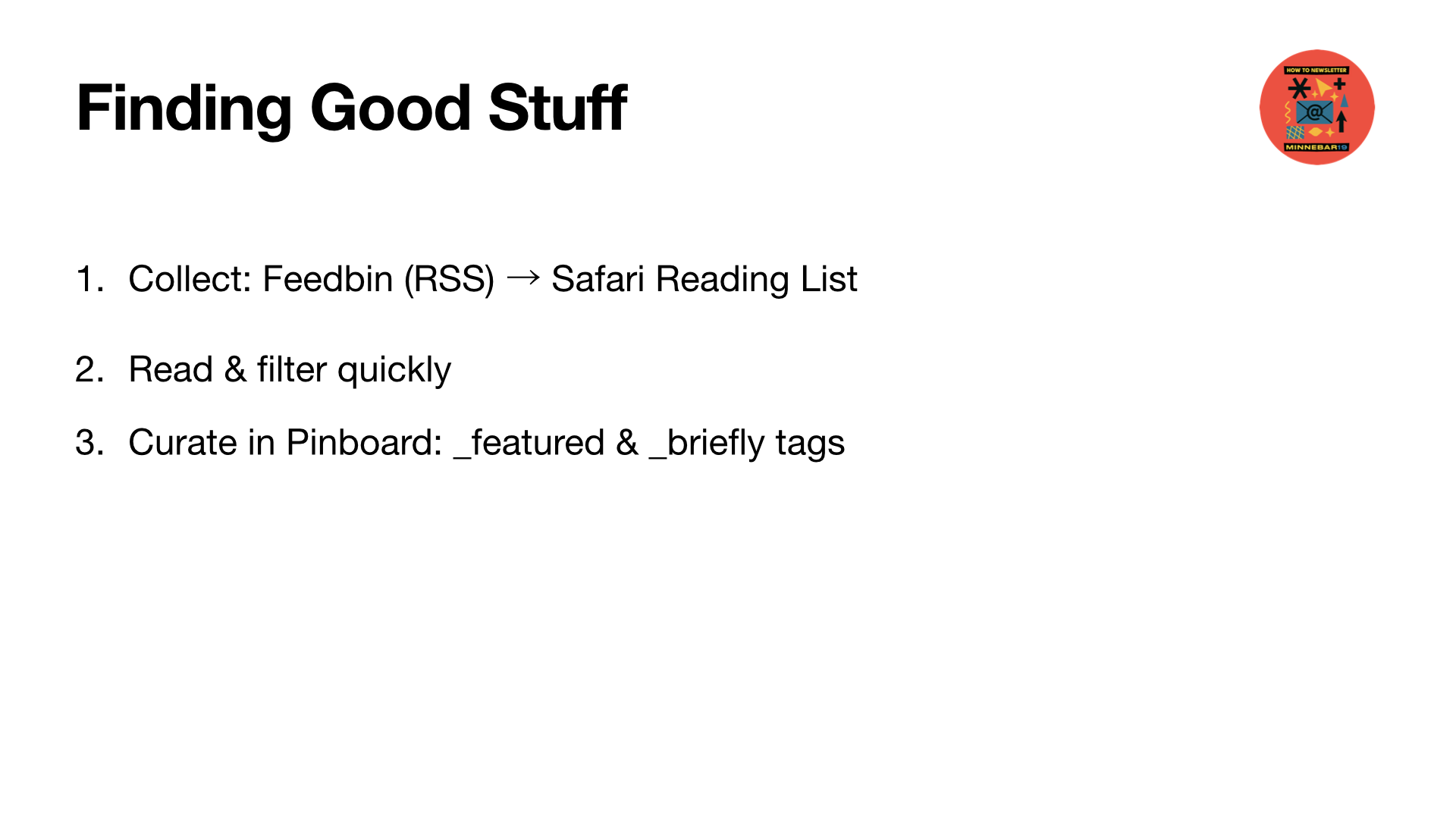
The first thing I had to solve: how do I find content? For me, it’s RSS. I’m a huge fan. I don’t get content from social media–it’s all RSS feeds and readers like Feedbin and Unread. No algorithms. I scan headlines efficiently and ask one question: is this interesting?
If yes, it goes into my Safari Reading List. From there, I narrow it down–maybe 100 items become 10. Then I read them more closely. The final step is saving them to Pinboard, my bookmarking tool. It’s super fast, hasn’t seen a new feature in a decade, and that’s totally fine. I also tag links there to mark if they’re a “featured item” or just a “brief.” That tagging helps structure my newsletter.
I also blog every week and include a photo I’ve taken that week–no cheating from the archive! That addition pushes my creative side and makes each issue more personal.

Now let’s talk about workflow. You can’t just have one OmniFocus task that says “Send newsletter”–there’s way too much involved. I’ve practiced GTD (Getting Things Done) for over a decade, and I use OmniFocus with TaskPaper templates.
Each issue is a full project, with variables like the issue number and date. I run a Shortcut that sets the new issue, defines the date, the range of days it covers, and then creates a project in OmniFocus. I like templates more than repeating projects because they let me make adjustments for each issue.
There are four main phases: create content, curate content, build it, and finalize it. And I spend very little time on the assembly because almost all of it is automated.
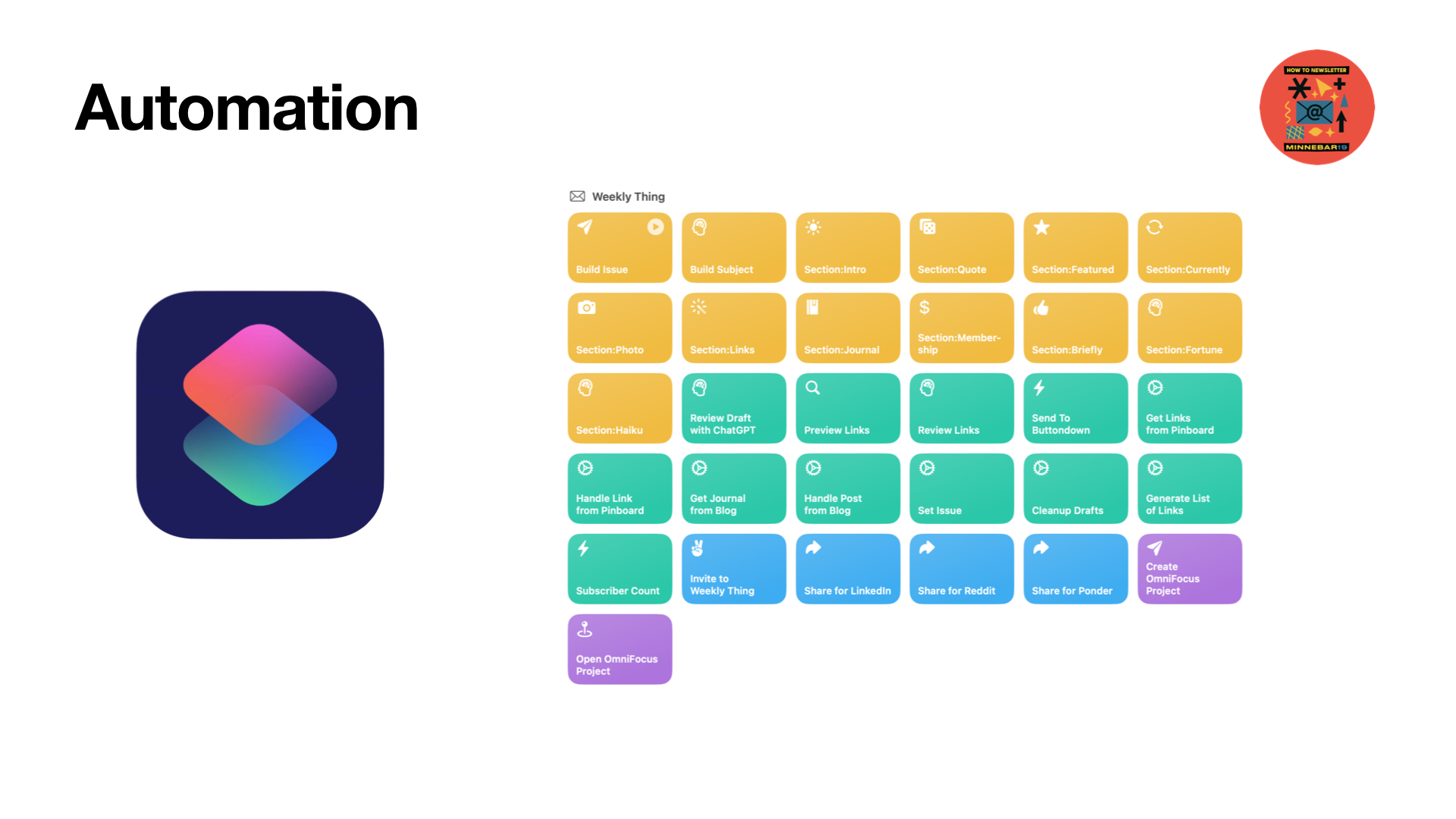
The key tool for automation? Shortcuts. You have it on your iPhone and Mac. I’ve built dozens of Shortcuts to run everything from creating sections to finalizing output. Each section returns Markdown. One Shortcut runs the list, combines them, and boom–newsletter built.
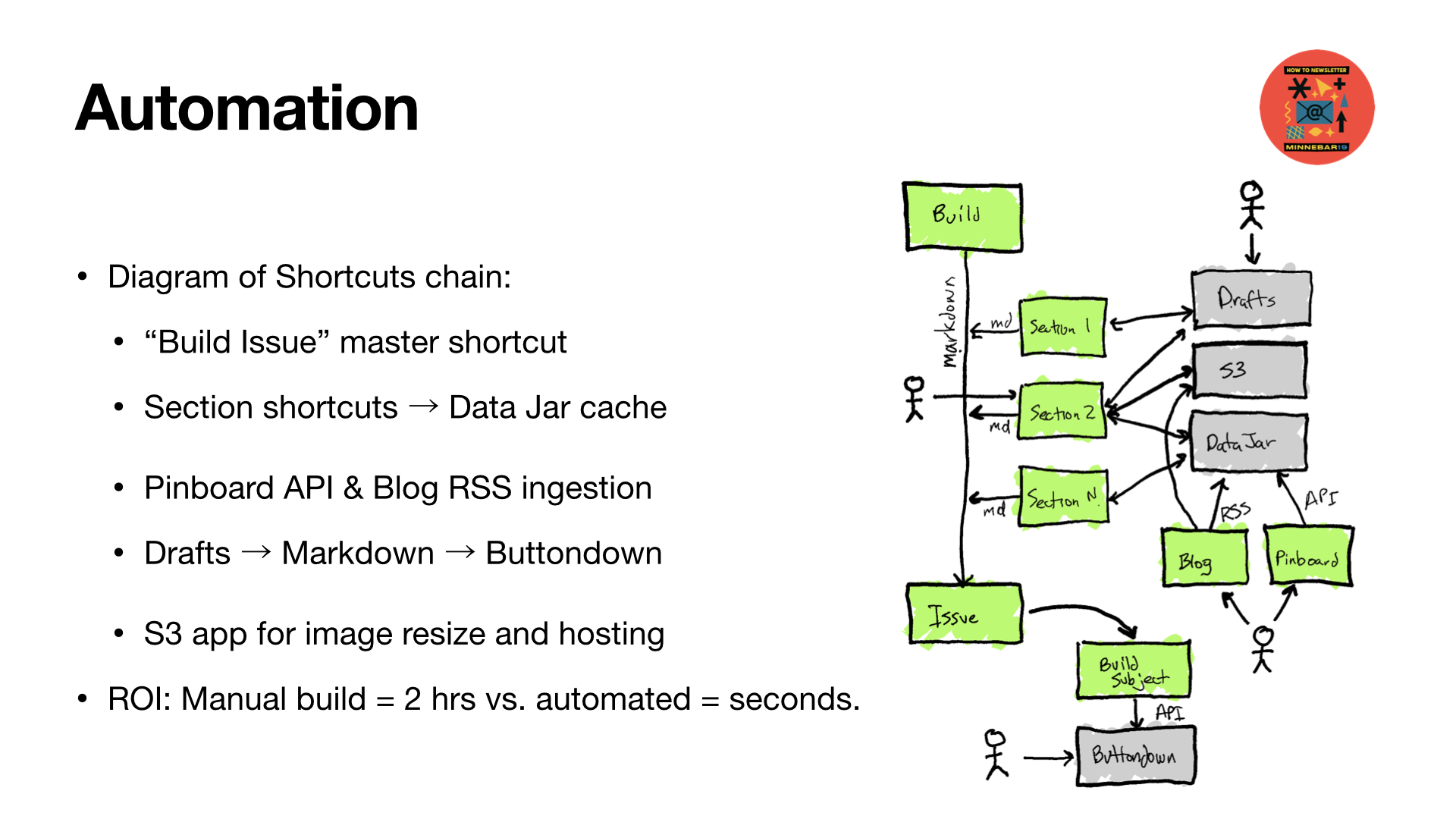
Here’s how it works. One main Shortcut runs an array of other Shortcuts. Each returns a Markdown section like intro, quote, featured, currently, etc. They can pull from APIs, my blog (via RSS), Pinboard, and Drafts. I store shared data in Data Jar–a kind of lightweight, shared memory for Shortcuts.
So when I say “build the issue,” it runs each section, combines the results, and I’ve got a finished draft ready to go. All of this is lightweight–no Python, no compiling, just using built-in tools.
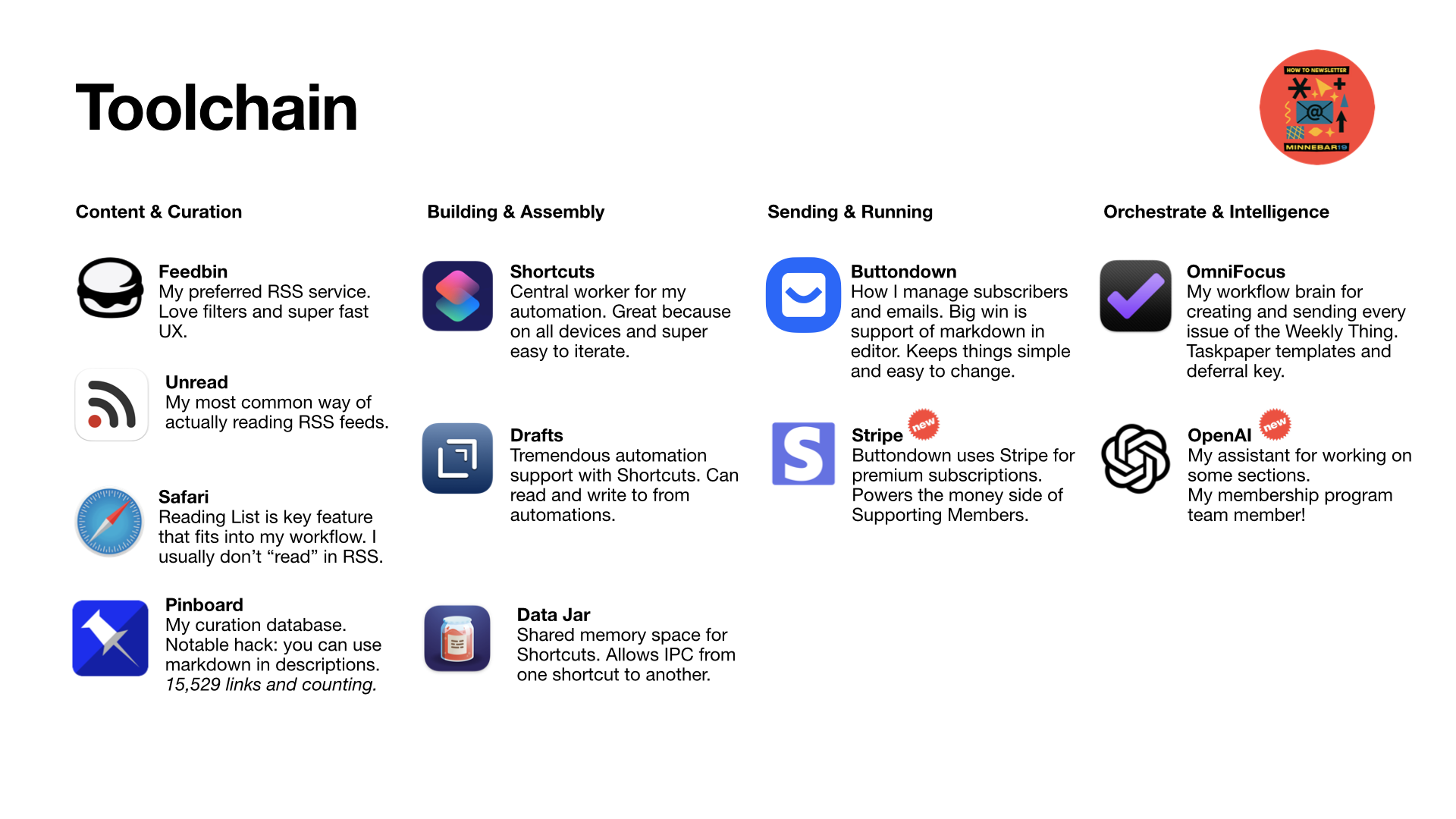
Here’s my toolchain and why I use each part:
Each piece of this toolchain plays a role. They’re like instruments in an orchestra, and together, they make this weekly project sustainable and honestly kind of delightful to run.

Let’s talk AI. I don’t use it to write for me–I’m protective of my voice. But there are areas where it helps. One is creating the subject line. I give it instructions: avoid publication names, maybe use alliteration, avoid negative terms, and be fun. Then it suggests five options. I pick the one I like–or modify it.
I also use AI to generate a fortune at the end of each issue, based on that week’s themes. And the Supporting Membership emails? Those are written in a different voice, and I let AI take more control there. It’s actually kind of fun to create a character out of that voice–something that feels separate from me.
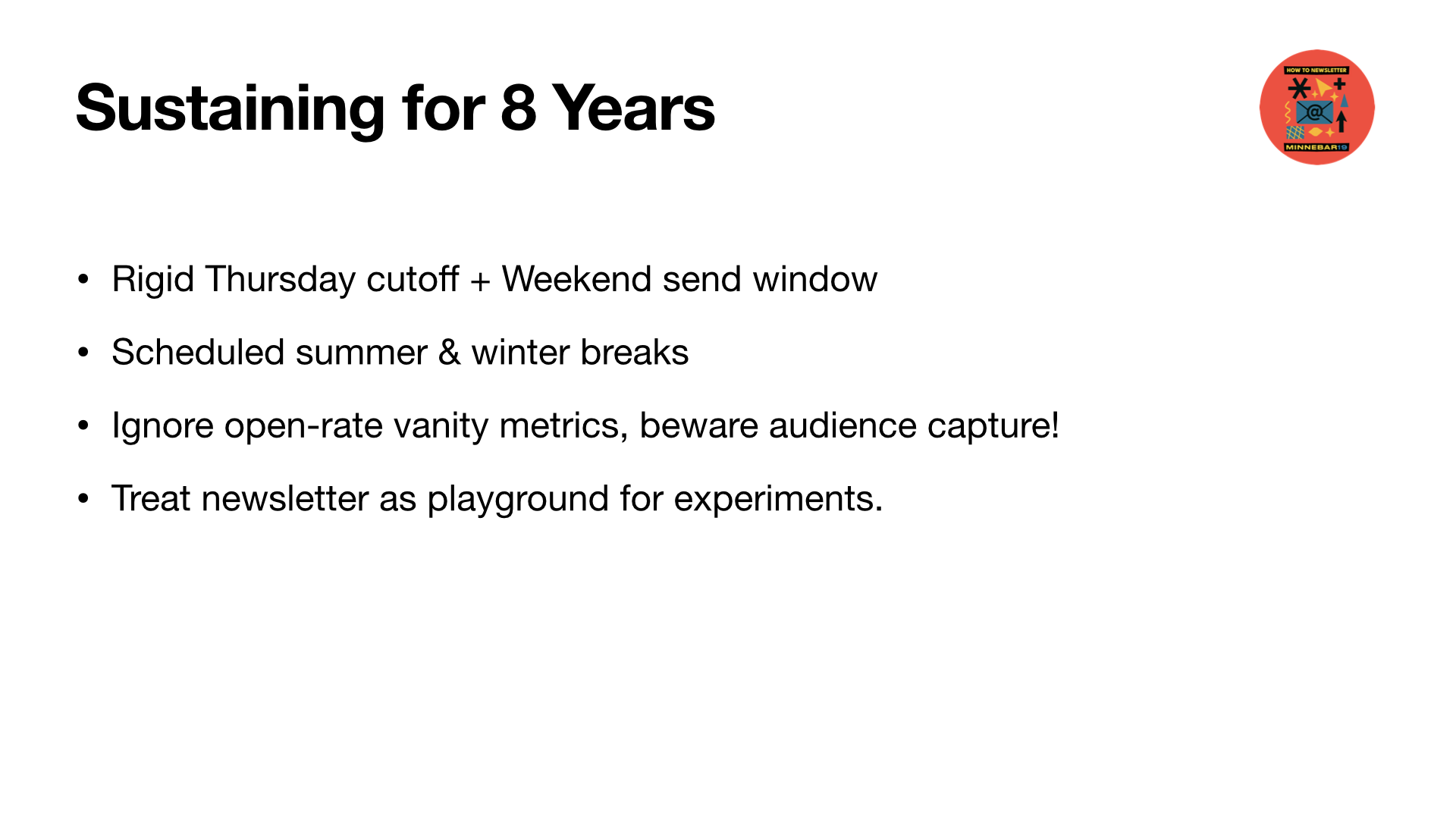
Sustainability over eight years requires boundaries. I cut off new content Friday night, giving me time to assemble and write. I also build buffers–if I miss Saturday, it goes Sunday.
And I take real breaks: July and August, plus mid-December through mid-January. These breaks keep me from burning out. I think I’d have quit long ago if I didn’t step away like that.
And this is a big one–I don’t look at analytics. I don’t track opens or clicks. I don’t want to be influenced by what gets engagement. I’m doing this to share what I find valuable. I don’t want to chase metrics. Every week, some people unsubscribe. Every week, new people join. That’s the rhythm. And it’s okay.
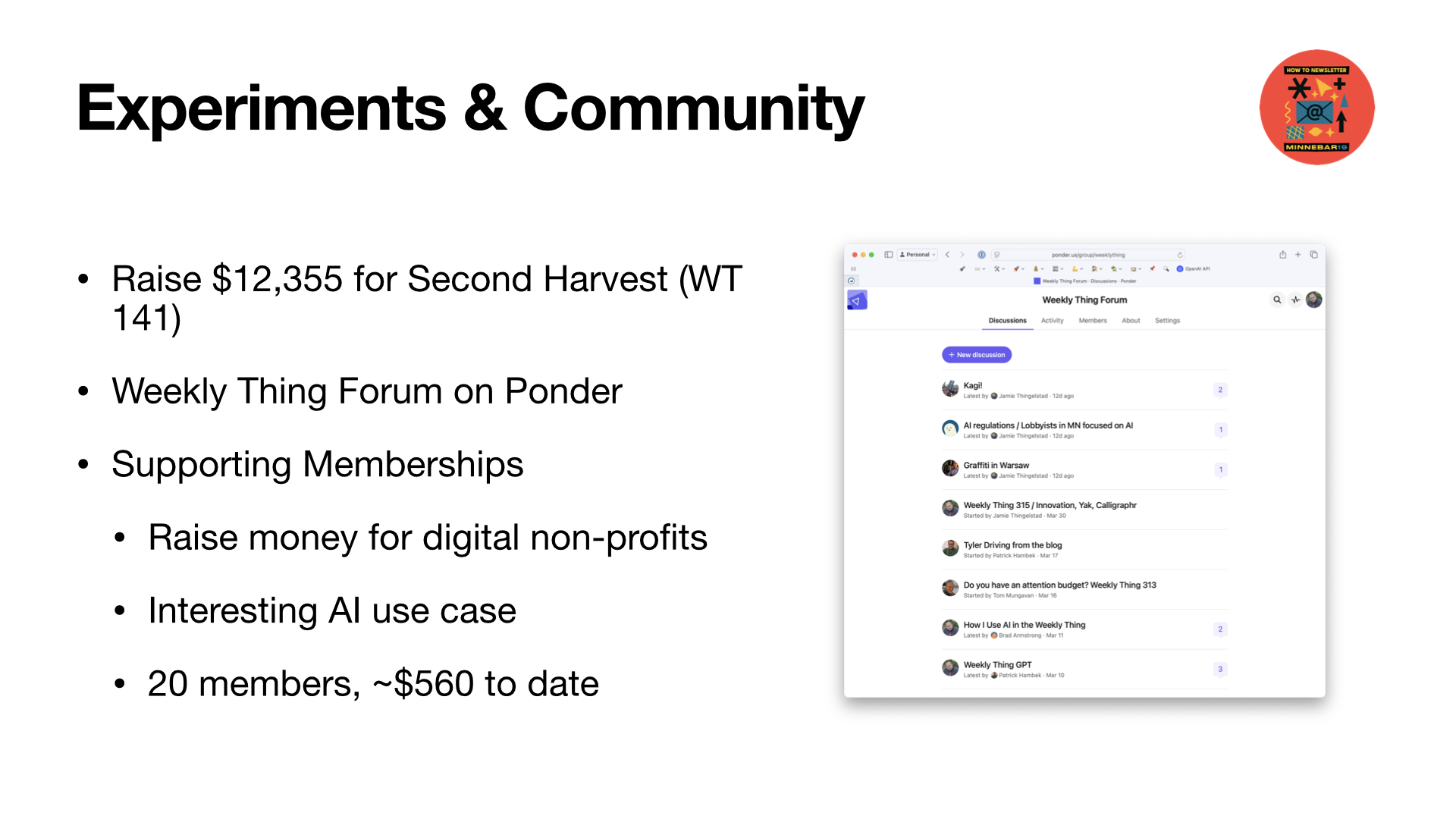
I’ve also treated the newsletter like a playground. During the pandemic, I raised over $12,000 for Second Harvest in Weekly Thing 141. I’ve tried launching a forum using Ponder. Community engagement is tough, especially via email. People see a newsletter as a message, not a conversation starter.
And I’ve started Supporting Memberships. Each year, I pick a nonprofit to support. This year, it’s Creative Commons–we’re on track to raise around $560. Next year I’m thinking Electronic Frontier Foundation.
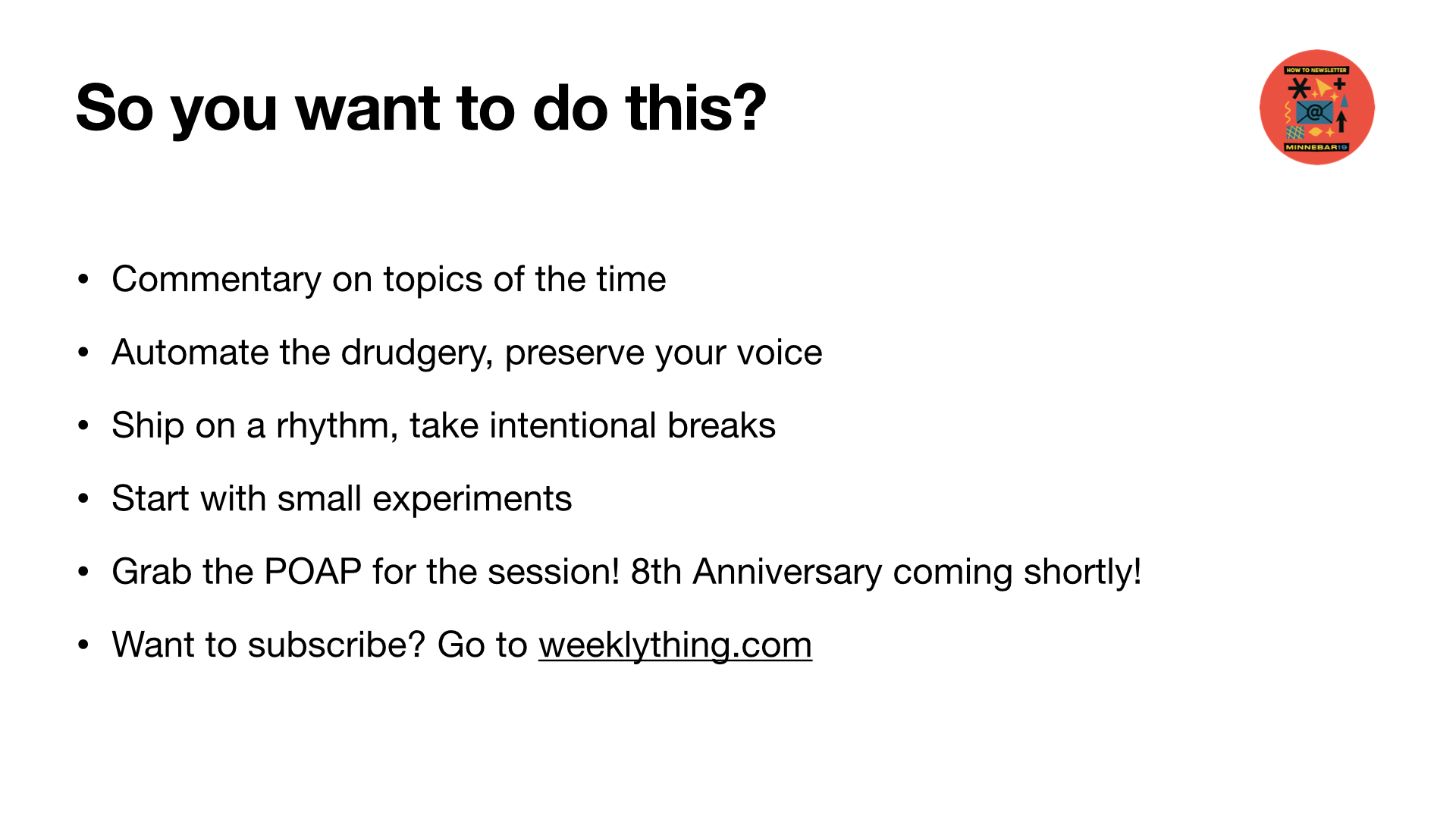
So, some final thoughts:
Automate the drudgery. Save your energy for your words. Really preserve your voice. I do some spellcheck with AI, but I avoid grammar checks–they over-correct and erase personality. I’ll ask AI to point out unclear sections, but I always make the edits myself.
And if you’re thinking about doing this, start small. A newsletter doesn’t have to be forever. You could do one for a project, or a trip. Newsletters are a great medium–no platform noise, no algorithm drama. Just you and your readers.
And if you want to subscribe, head over to weeklything.com. The eighth anniversary edition is coming up soon–and yes, there’s a POAP for that too.
That’s all I’ve got. Happy to take any questions!
Related Articles
Further reading…
Me and my cousin Quinn wrapping up a great day at Minnebar 19 — it was my 19th Minnebar and his 1st! Related, I’m the oldest of the cousins and he is the youngest, with 13 more between us.
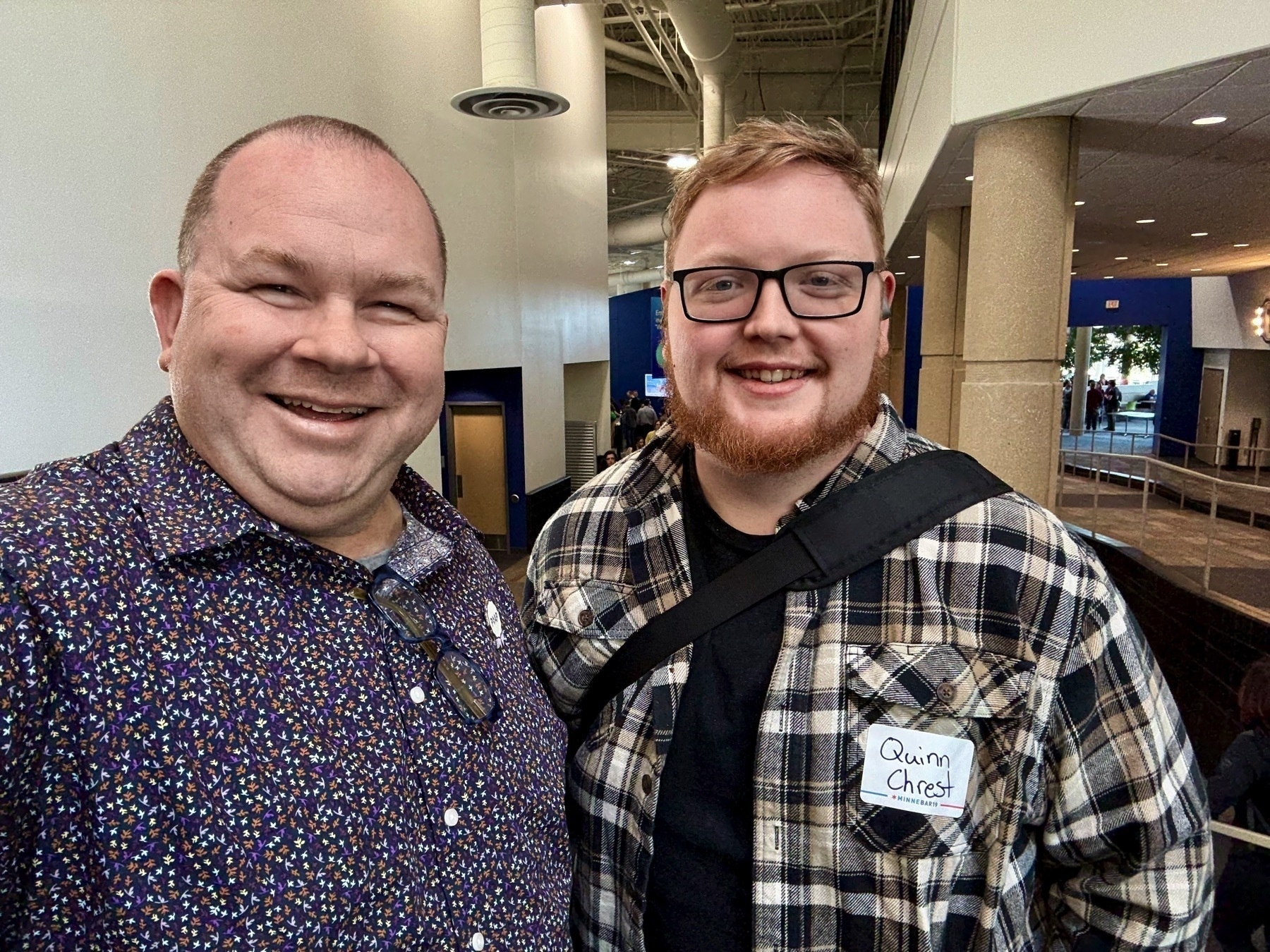
I love the passion and excitement that people bring to the Mega-Minne-Multi-Indie-Mini Arcade at Minnebar.
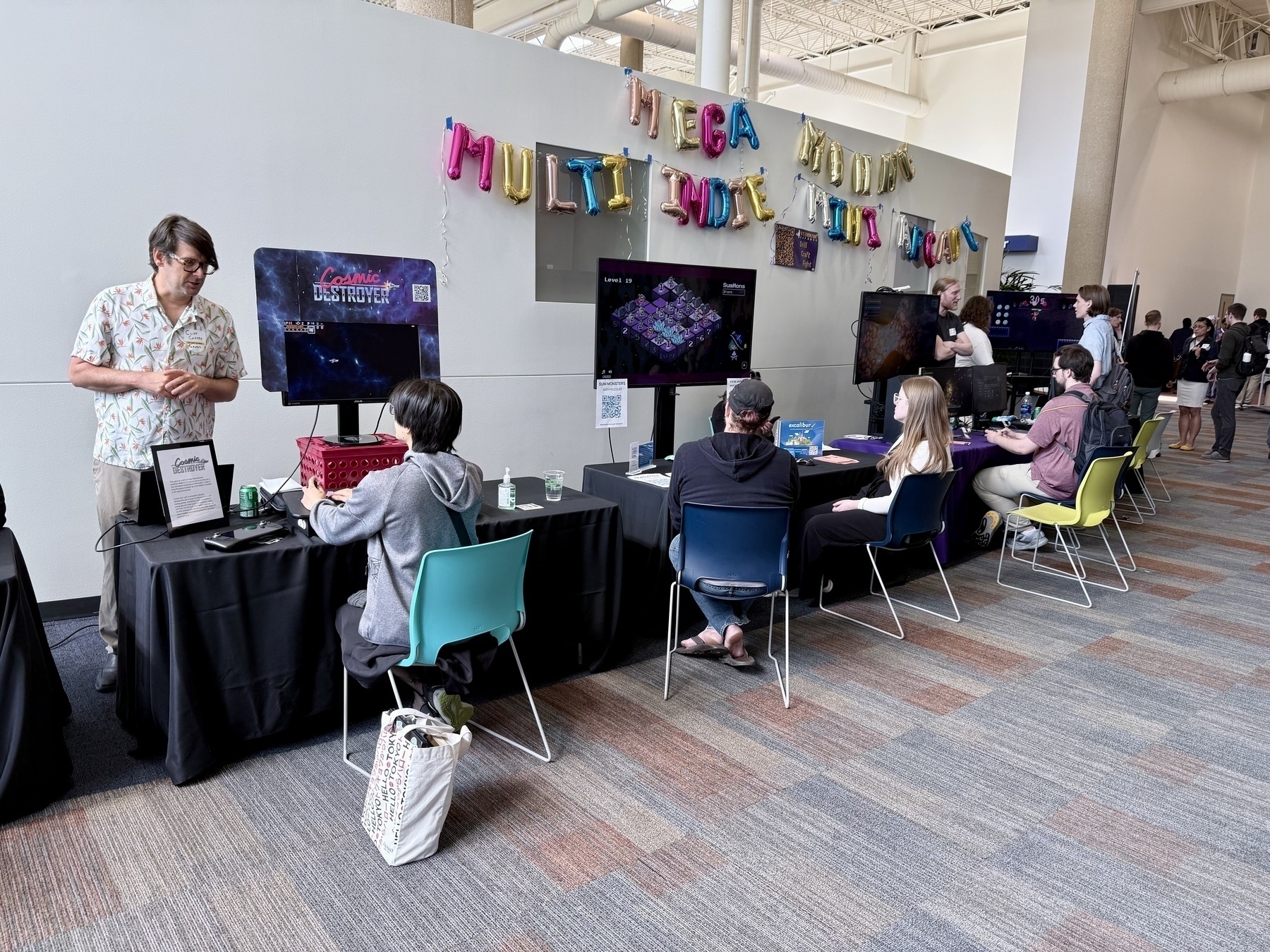
Garrick van Buren, Jim Bernard, and I after his Minimal Viable Polka session at Minnebar 19. I feel very confident that this is the first accordion experience at Minnebar — and it was a great time!
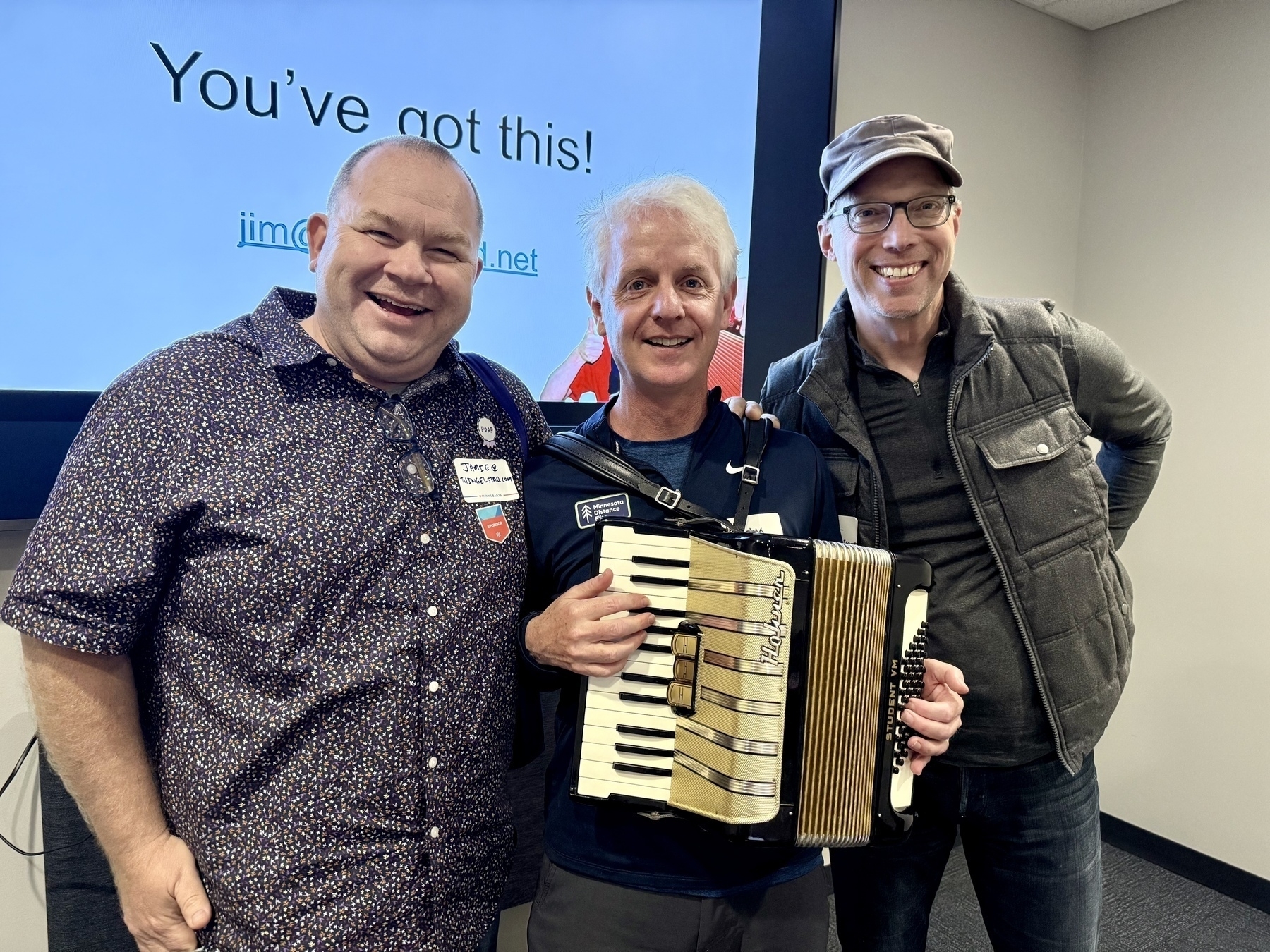
Great to have so many #TeamSPS folks here at #Minnebar19! Know more to be more! 💙

Stats on Minnebar 19:
Wow! 😮
Super strong kickoff to Minnebar — one of the best I can recall. Great energy, logistics well orchestrated, materials very well done. Amazing. 👏👏👏

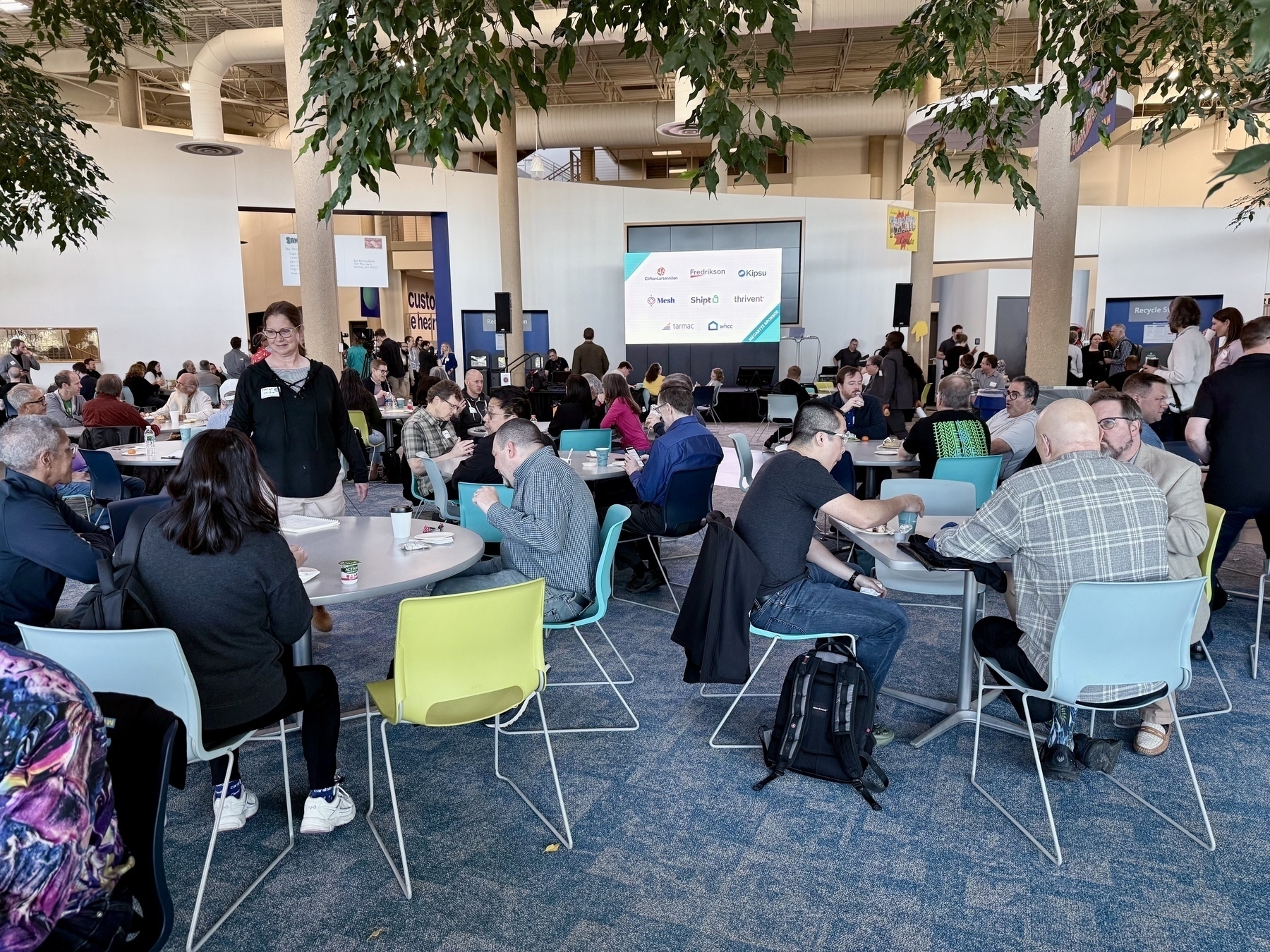
Hey #Minnebar19 attendees — you can get your awesome Minnebar 19 POAP by tapping your phone on the “NFC discs” at the t-shirt table, newbie desk, or by the main stage!
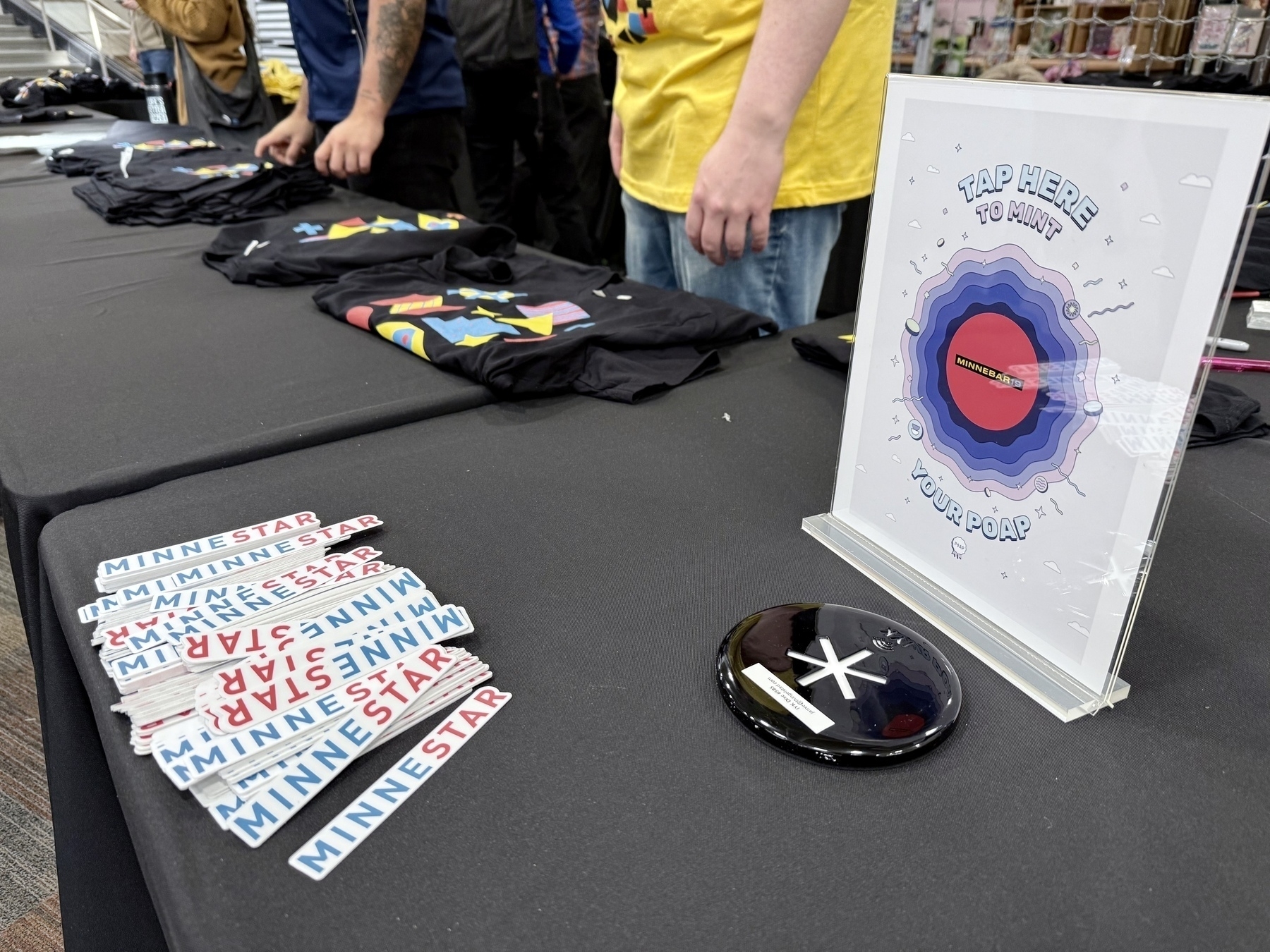
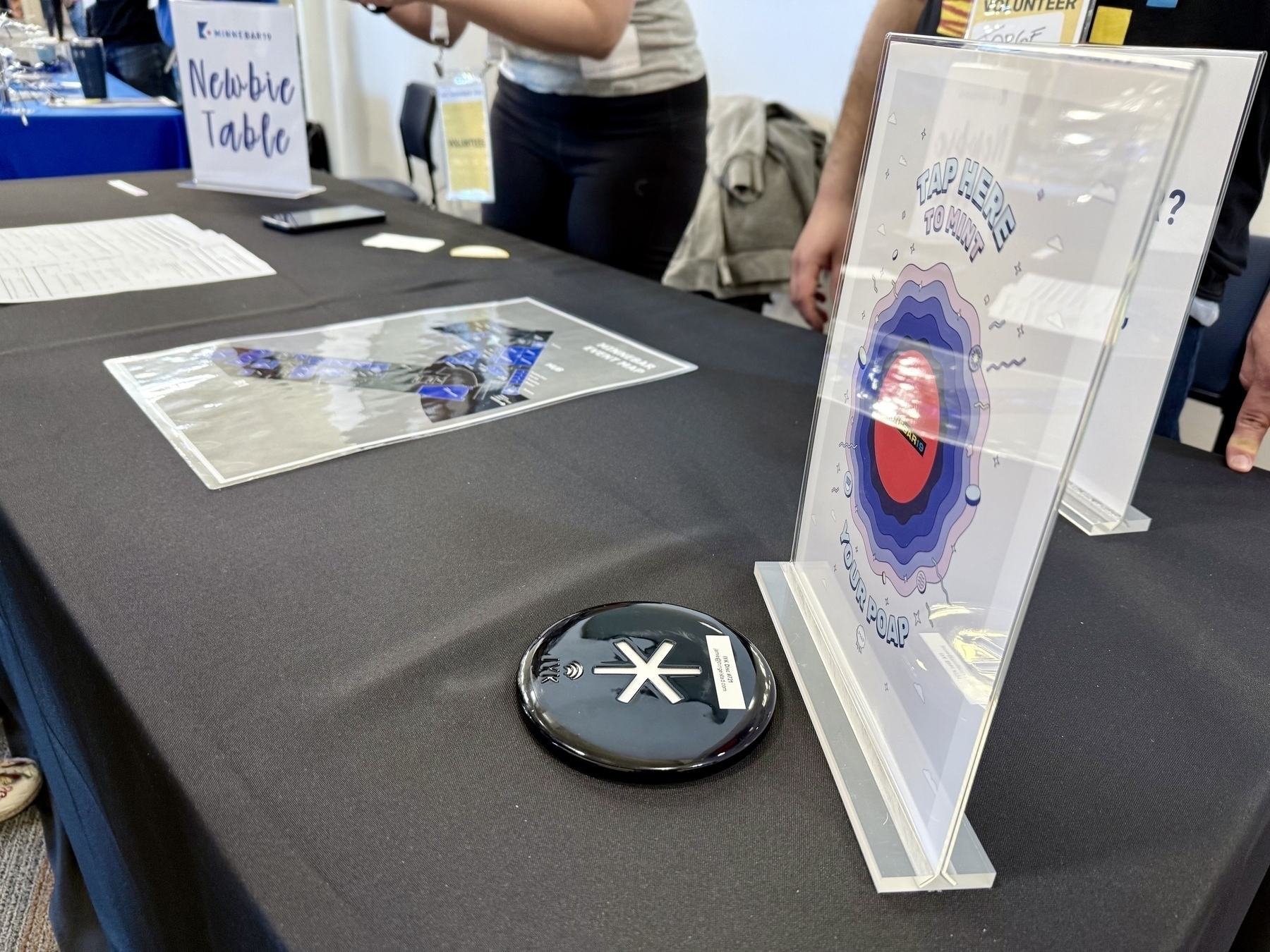
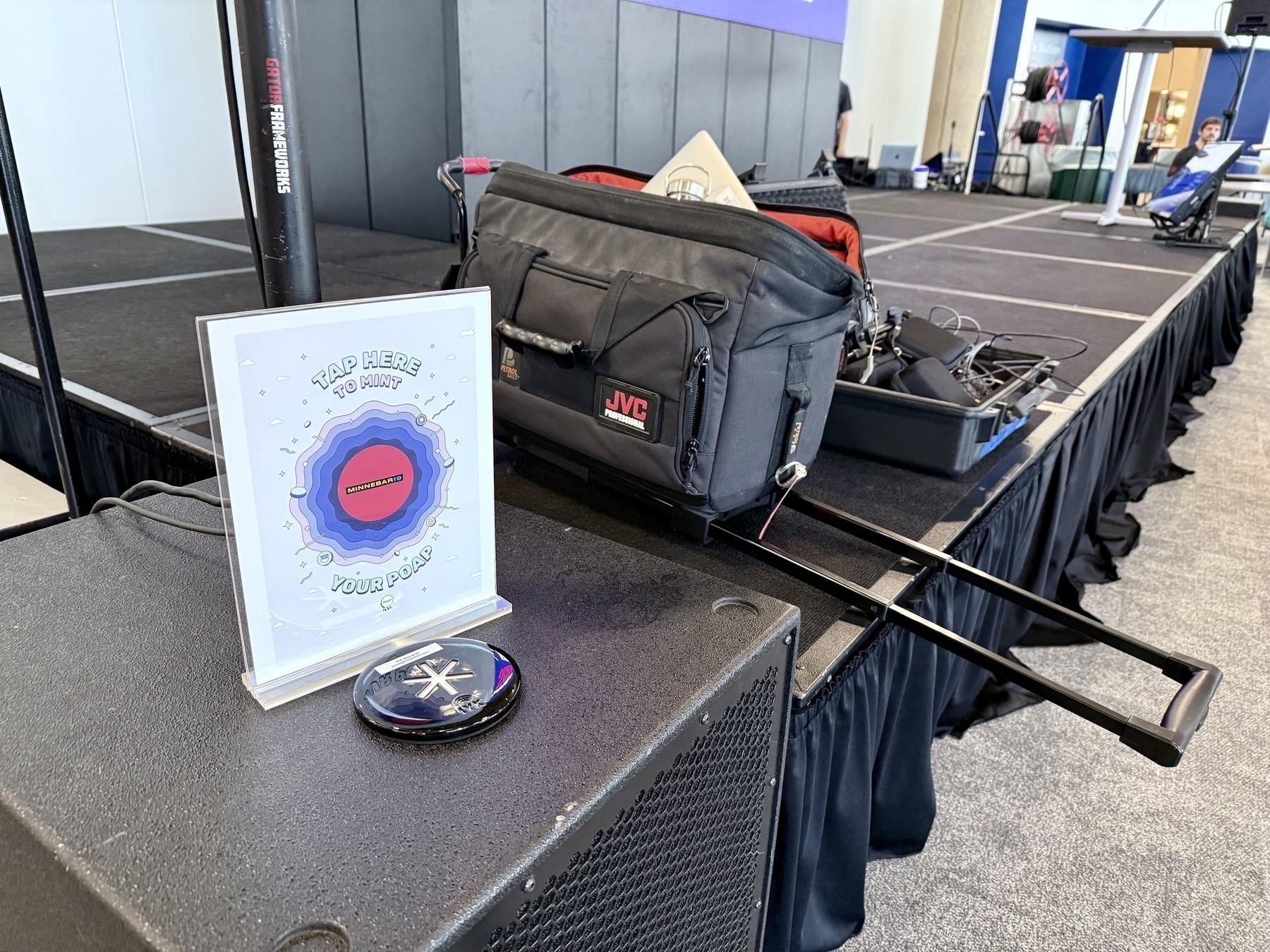
Minnebar 19 POAP
Minnebar 19 is coming up this Saturday and I couldn’t pass up the opportunity to create a special Minnebar 19 POAP token for folks at the event to get and commemorate the event! I did a POAP for Minnebar 17 two years ago.
For this POAP I reached out to Meg Steuer at Minnestar and she was kind enough to share the graphics that are being used for the t-shirts. It was a super cool shirt and after consider it for a bit it worked absolutely perfect for an animated image. I’m loving this loop!
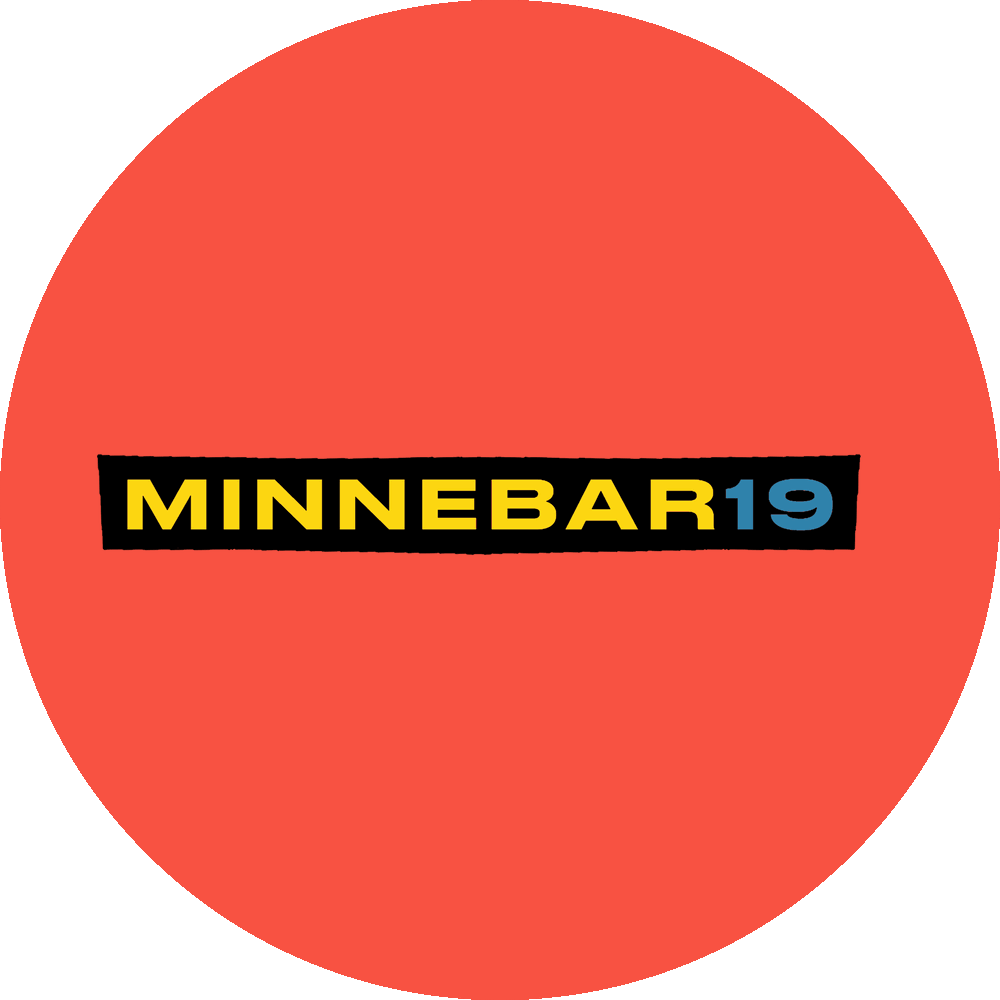
I have several hundred tokens loaded on three different POAP NFC discs that will be placed around the event. Just bring your phone near the disc and tap the center — you’ll get directed to a link to mint your token!
If you want to get ready for the day, download the POAP Home app to be ready for iOS and Android. Using this app you can also upload photos from the event to POAP Memories to share with others that hold the same token.
I’ll also be sharing my You Met Me POAP as well as a one for my How to Newsletter Session.
POAP 7343290 at Minnebar 19.

POAP 7343289 at Minnebar 19: How to Newsletter.
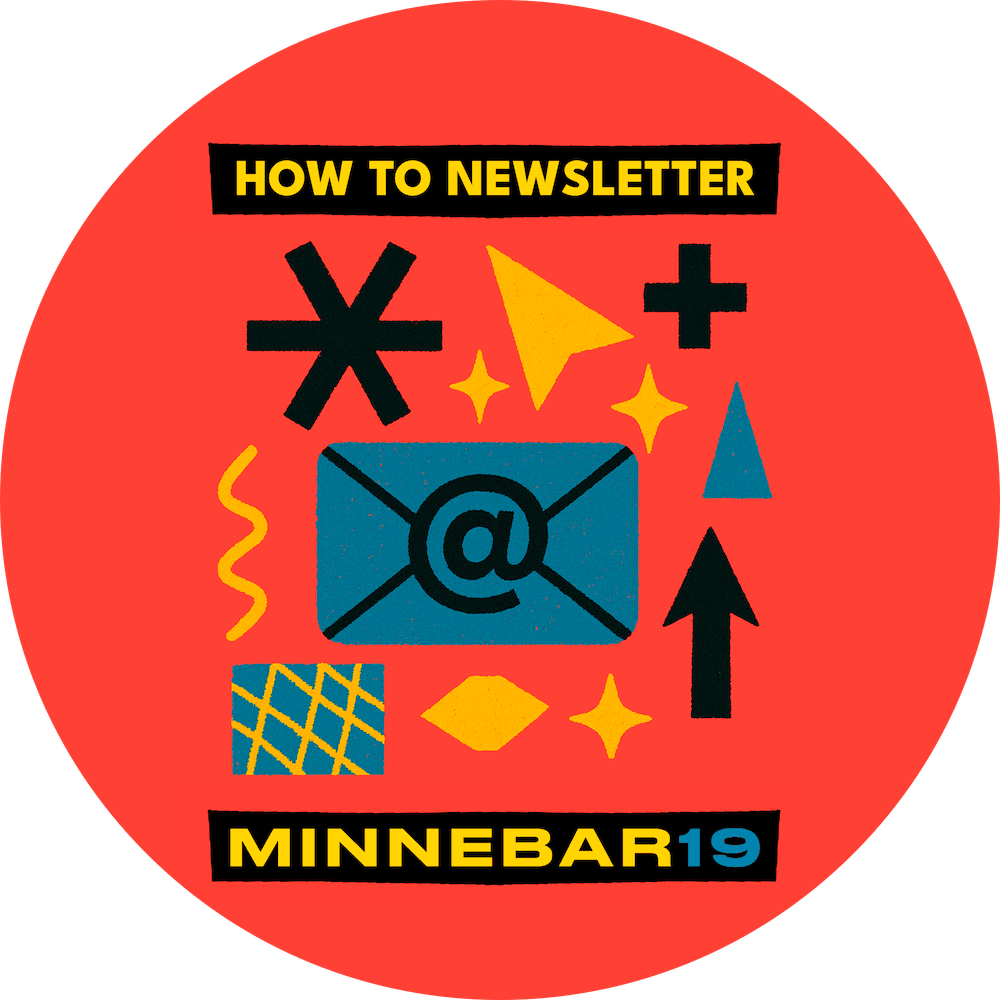
Minnebar 19 "How to Newsletter" Session POAP
I made a special POAP just for folks that attend my How to Newsletter session at Minnebar 19! If you join this session I’ll have a NFC card in the room you can tap to add this fun one to your collection!
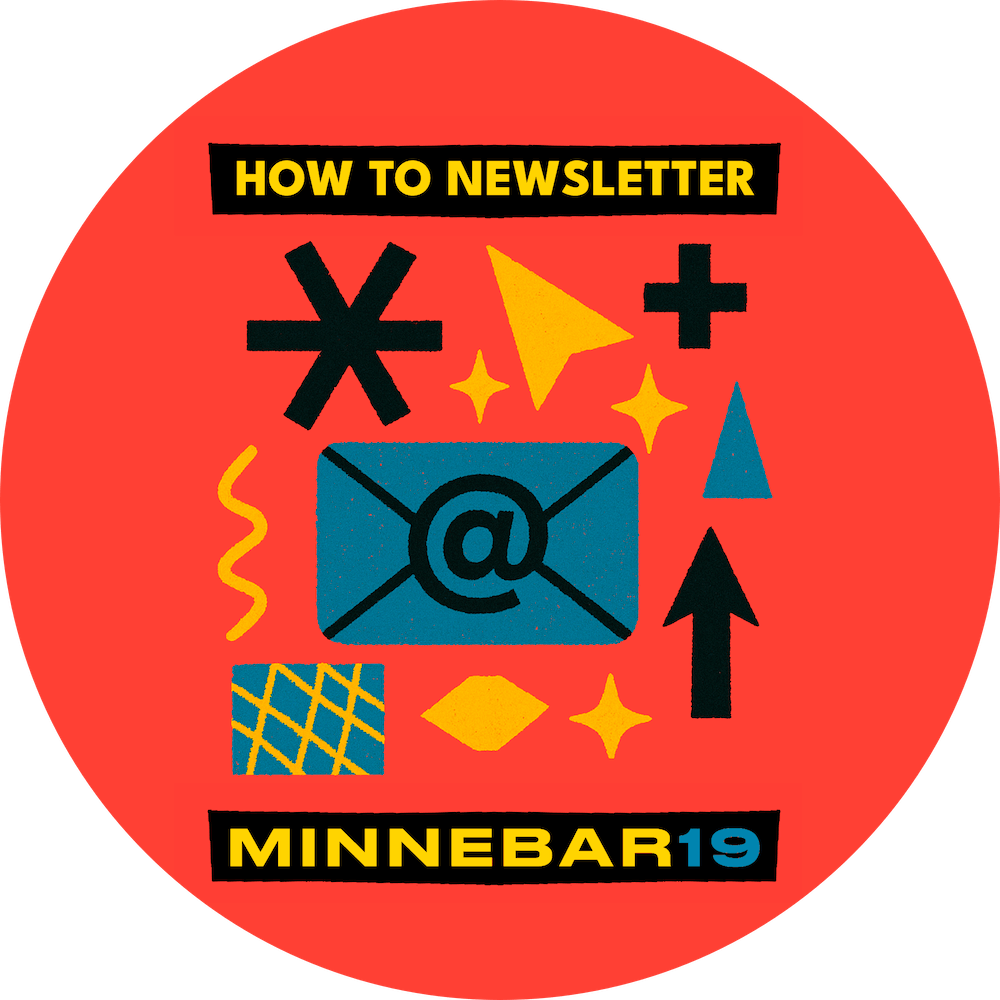
We Met at Minnebar 19 POAP
Are you going to be at Minnebar 19 this Saturday? Come and introduce yourself and I’d love to share my You Met Jamie Thingelstad at Minnebar 19 POAP token with you! I’ll have it loaded on my IYK card easily redeemed with a tap.

Created the designs for three different POAPs for Minnebar 19 next week. Have a very cool one for the event, made a special one just for my session, and of course a You’ve Met Me one to share at Minnebar!
POAP Planing for Minnebar 19
I’m going to distribute a POAP for Minnebar 19! This isn’t official (yet) — but something I’m doing for the community. I’ll have three IYK POAP Discs at the venue for claiming the tokens. This will be simpler and easier to distribute than what I did for Minnebar 17.
I’ll also have a POAP Card at my newsletter session for a special POAP just for that session, as well as a personal IYK Card loaded with my “You’ve met me POAP” to share at the event.
Getting ready? Install the POAP Home App (iOS, Android) and you are good to go!
I signed up to run a session at Minnebar 19! I’m going to host How to Newsletter: Lessons from 300 issues of the Weekly Thing. I had originally planned do this at Minnebar 17 but had to cancel. I’m looking forward to going deep and broad on how I do all this! Come if you are in Minneapolis!
Got my tickets to Minnebar 19! Tyler and I are both going. I’m planning on doing a session this year as well. More to come!

